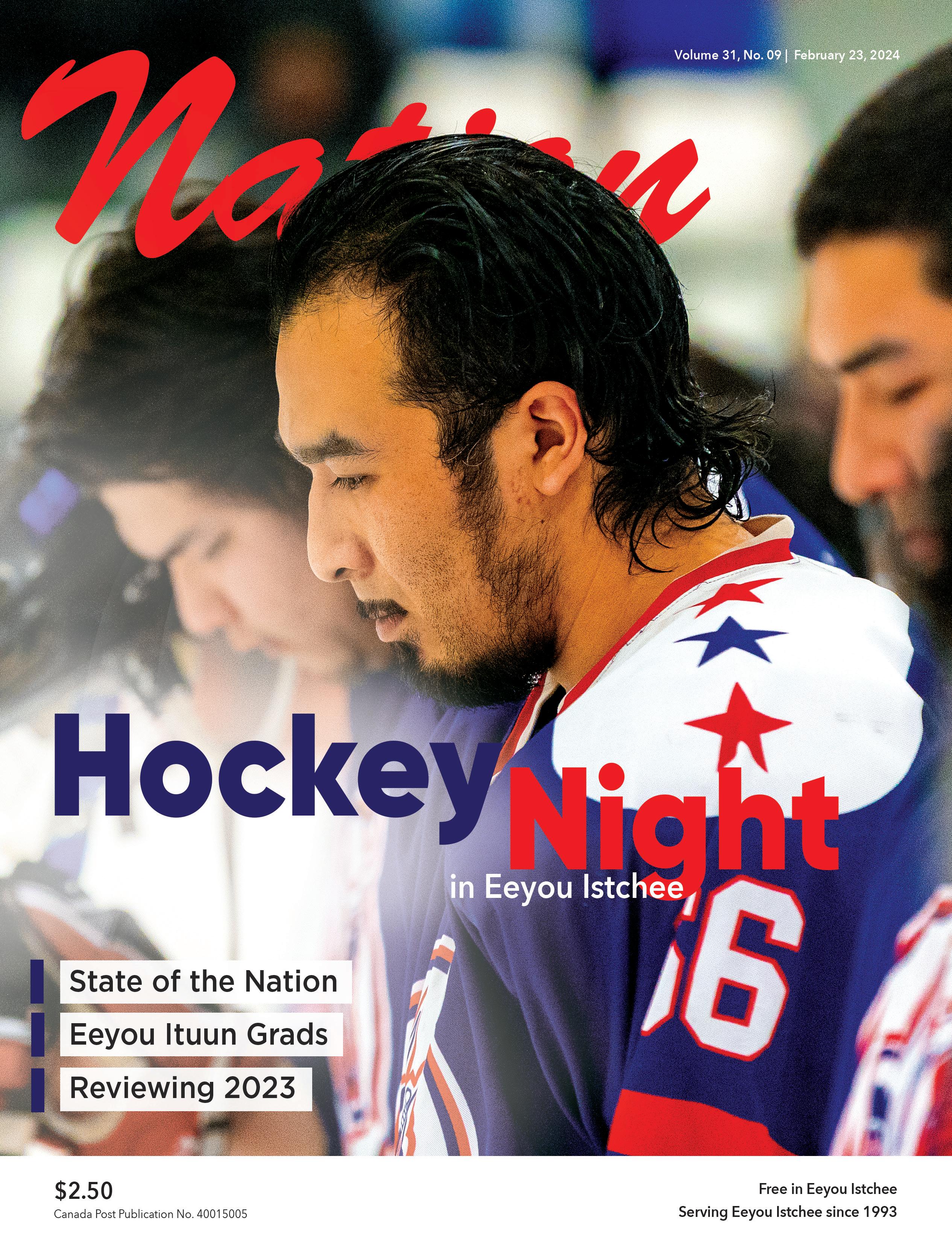
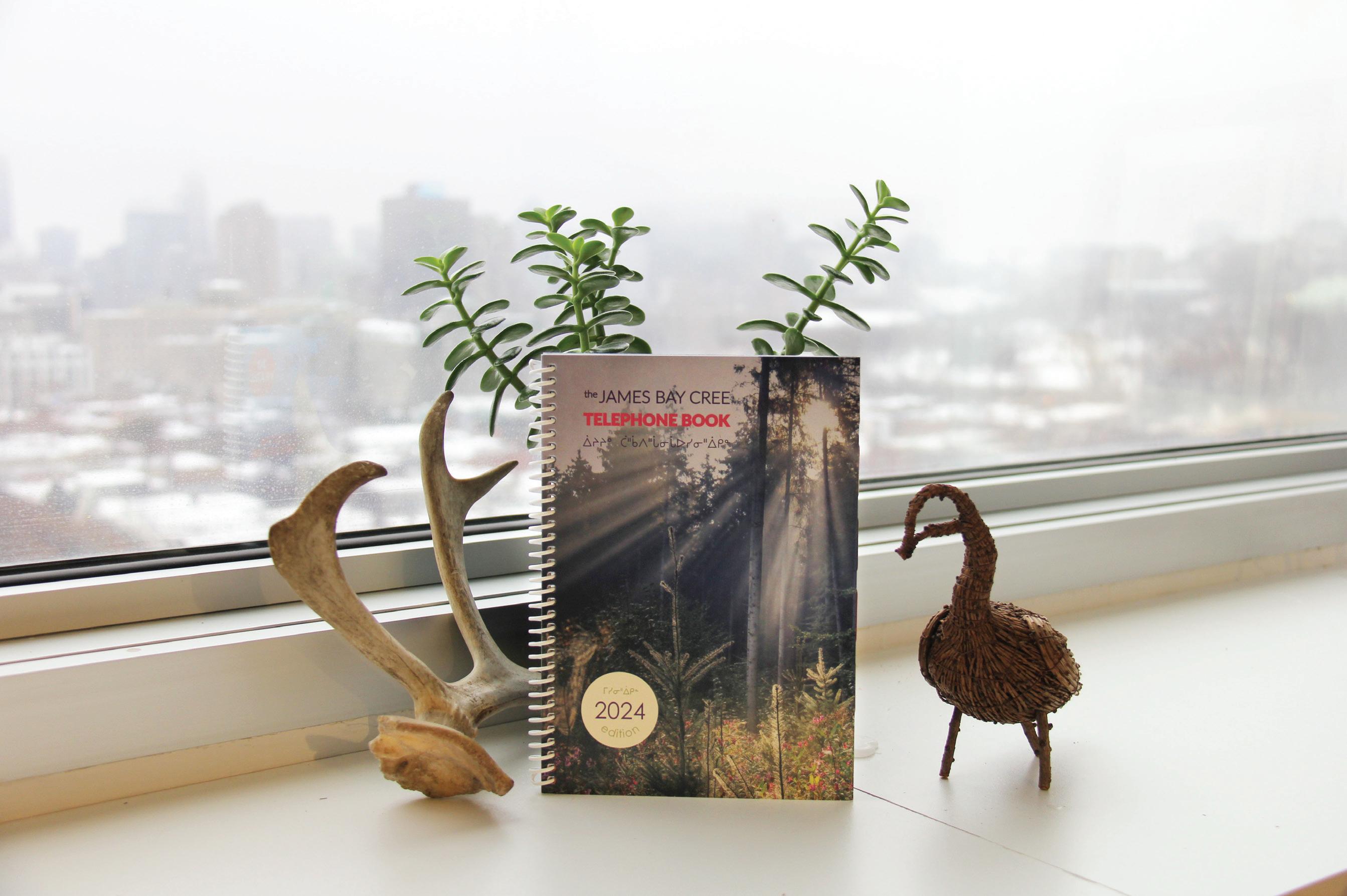
Also
CONNECTING THE CREE COMMUNITIES FOR 27 YEARS JAMES BAY CREE TELEPHONE BOOK Free to all community residents and entities in Eeyou Istchee 514-272-3077 info@beesum.com beesum.com
available for sale Contact us to purchase a copy CONNECTING THE CREE COMMUNITIES FOR 27 YEARS JAMES BAY CREE TELEPHONE BOOK Free to all community residents and entities in Eeyou Istchee 514-272-3077 info@beesum.com beesum.com
Also
available for sale Contact us to purchase a copy

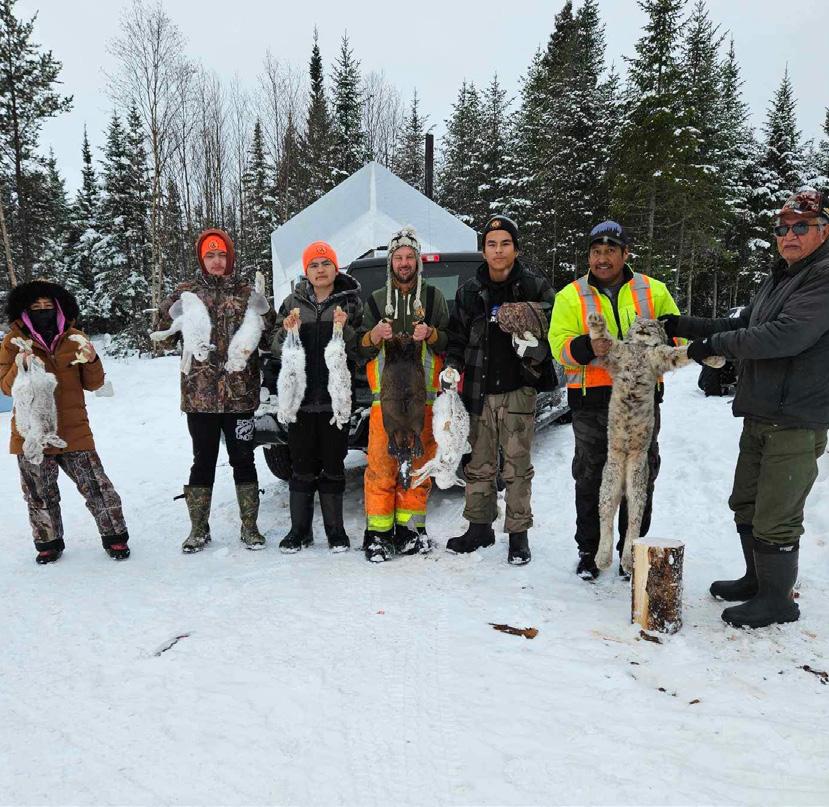

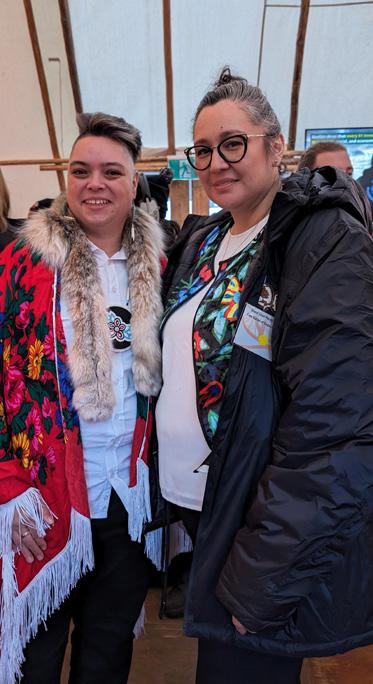
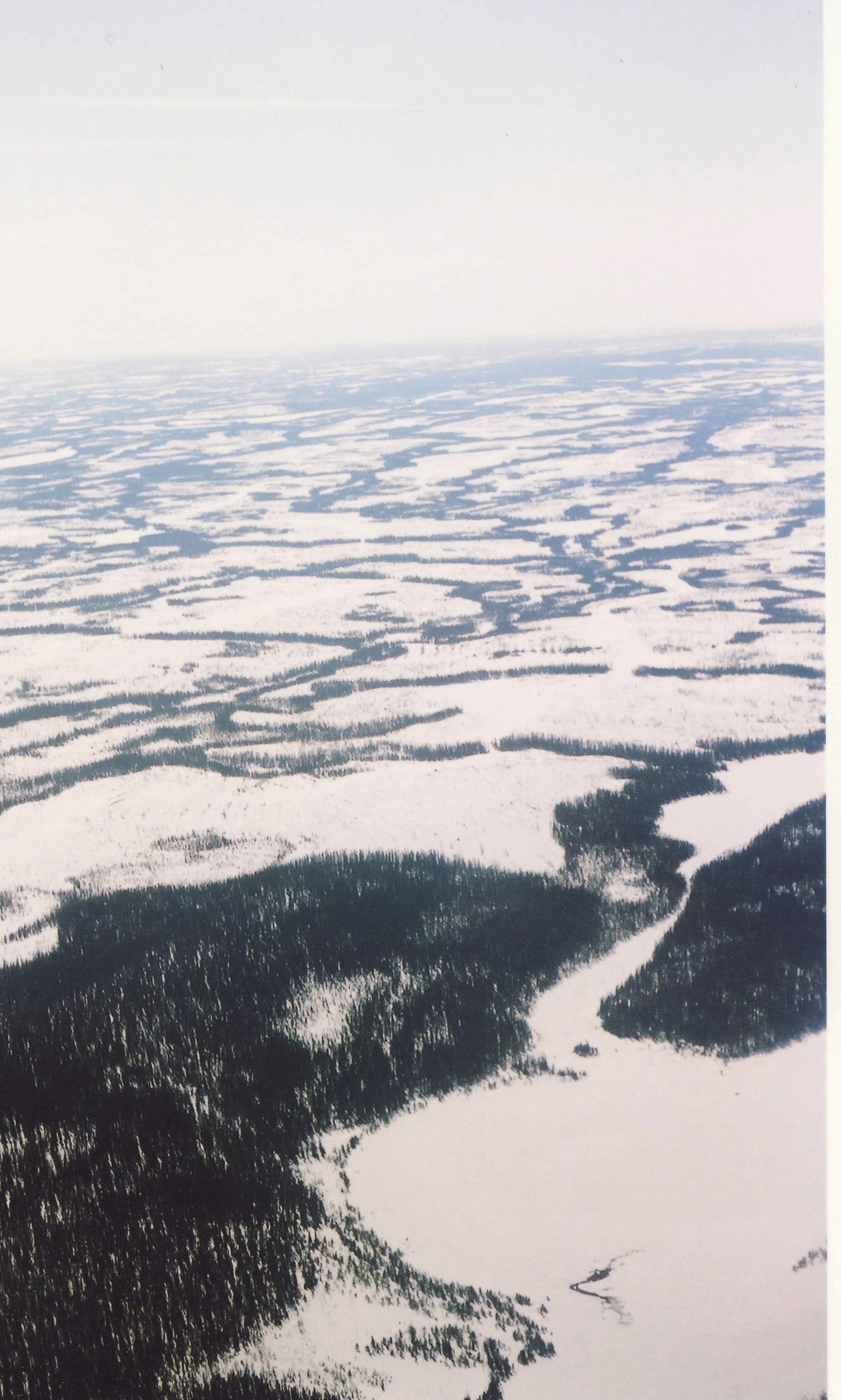
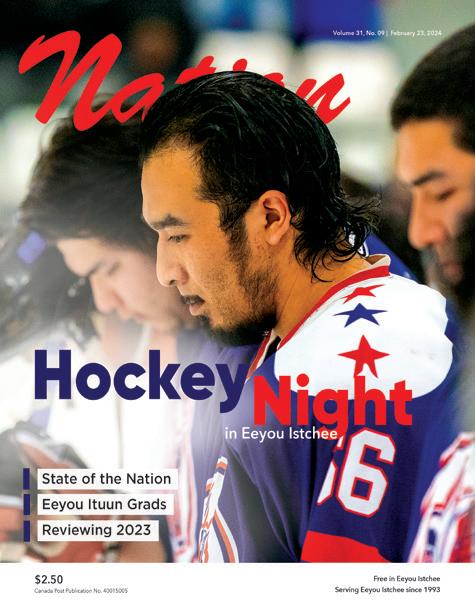




CONT ENTS Taking in the action 10 1 800 361-2965 1 800 661-5850 ᐅᕙᓂ ᐱᒋᐊᕐᐳᖅ ᓄᓇᕕᒃ Nunavik Starts Here RESERVATIONS 1 800 361-2965 ᖃᖓᑦᑕᔫᓂᒃ ᐊᑦᑕᑐᐊᖃᕐᓂᖅ CHARTERS 1 800 661-5850 ᐅᕙᓂ ᐱᒋᐊᕐᐳᖅ ᓄᓇᕕᒃ Nunavik Starts Here State of the Cree Nation Eeyou Ituun program Annual Waskaganish Hockey and Broomball tournament 18 16
EDITORIAL Climate change NEWS They’re our children Looking back BRIEFS FEATURES Sport & language Learning Cree knowledge State of the Nation PUZZLES REZ NOTES El Niño UTNS Valentine’s Day 4 5 7 9 10 16 18 24 25 26 Politics
Photo by Jonathan Levert of Image Nomade Productions
The expression, “when Hell freezes over,” means something will never happen. While this doesn’t apply to a recent Supreme Court of Canada decision, Hell must have gotten a little chilly.
That blast of cold air hit when the court announced that Quebec’s arguments against Canada’s decision to recognize the right of Indigenous Peoples to administer their own child welfare systems is unconstitutional.
The Supreme Court unanimously upheld the federal government’s Indigenous child welfare policies. In doing so, the court dismissed Quebec’s appeal of a landmark opinion that affirmed Indigenous Peoples’ jurisdiction over child and family services.
Bill C-92, An Act Respecting First Nations, Métis and Inuit Children Youth and Families, became law in 2019. It affirms that Indigenous nations have jurisdiction over child and family services and outlines national minimum standards of care. It’s a pleasant surprise that it only took five years to make it to Canada’s highest court.
With this judgment, Quebec’s frequent use of the notwithstanding clause is not available. However, another hurdle for any Indigenous community or organization is funding for new programs. Traditionally, child welfare and other social programs are provincially funded. The court ruled that the federal government should continue its role in Indigenous child welfare. But what we don’t know is whether will funding come from Ottawa, the provinces or both?
More disturbing, however, is Quebec’s contention that the law made Indigenous
change
Editorial by Will Nicholls

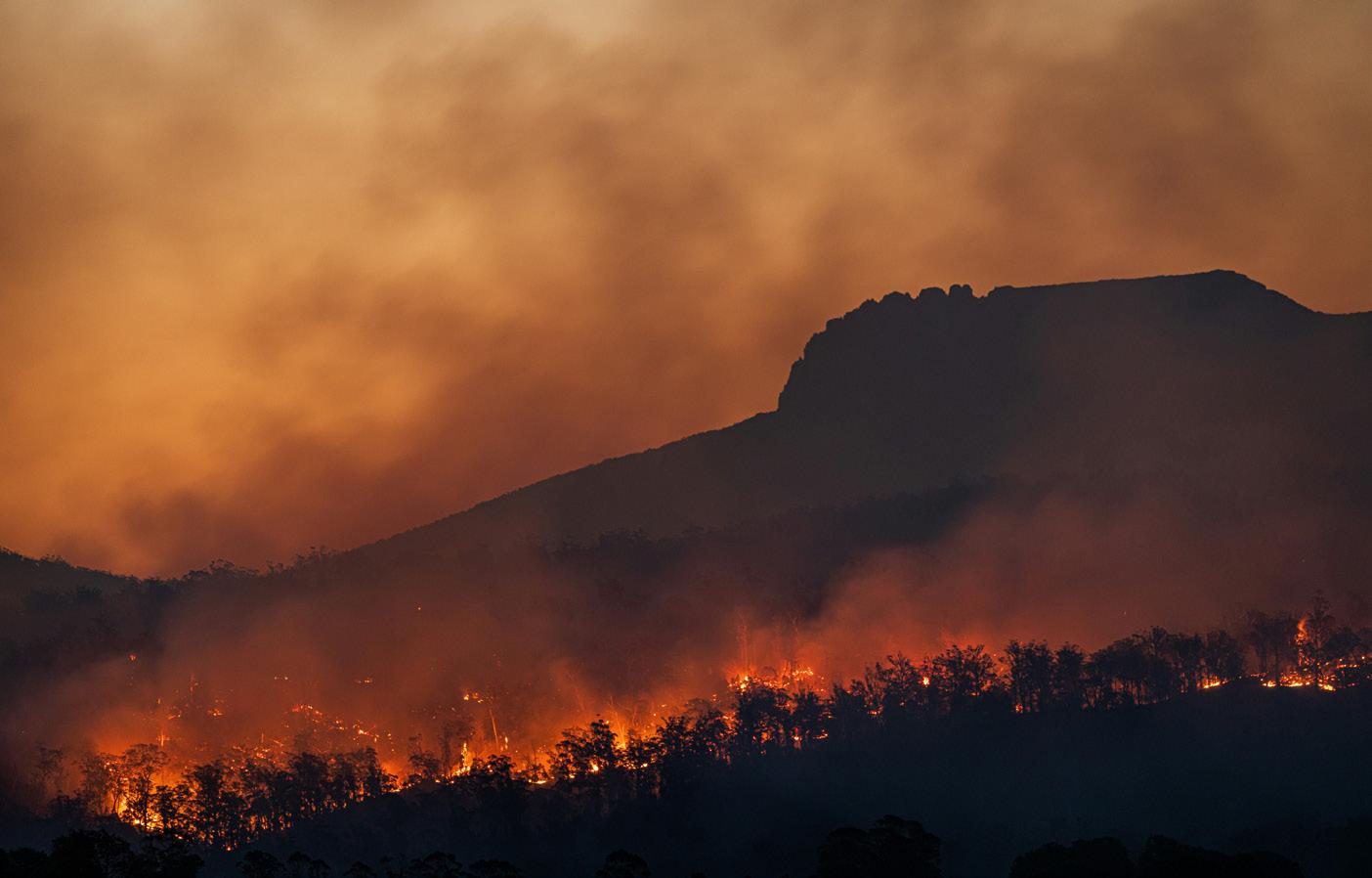
Peoples a third order of government, something it staunchly opposes. The Supreme Court rejected this argument, saying it is simply an acknowledgment of constitutionally recognized rights.
Nonetheless, t stance subtly reveals the Legault government’s true outlook: that only some groups of people in Quebec have rights; Indigenous Peoples clearly do not enjoy rights equal to all others in the government’s view.
Don’t forget, despite this official, publicly acknowledged discrimination against Indigenous people, the government strenuously denies that systemic racism exists here. Quebec has said the problem was never about Indigenous Peoples, but with federal overreach, and it will continue to analyze the situation. One wonders exactly what that means.
What is more surprising and warmly welcomed by Indigenous Peoples is that the court in part upheld Canada’s
implementation of the United Nations Declaration on the Rights of Indigenous Peoples. That could lead to a precedent beneficial to a great many other court cases filed by Indigenous Peoples. Strengthening UNDRIP by the Supreme Court of Canada in this manner is a true stepping stone towards reconciliation.
Many First Nations chiefs were overjoyed by the decision. “This decision ends the colonial era of Canada and the provinces controlling Indigenous child welfare. Our inherent right to protect our children and to hold them within their families and communities is reaffirmed,” said Grand Chief Stewart Phillip of the Union of British Columbia Indian Chiefs.
However, Quebec’s actions, coupled with its vague promise analyze the decision, makes us feel that it’s still hot as Hell here in Quebec. Climate change anyone?



4 the Nation February 23, 2024 www.nationnews.ca
The Nation is published every two weeks by Beesum Communications EDITORIAL BOARD L. Stewart, W. Nicholls, M. Siberok, Mr. N. Diamond, E. Webb EDITOR IN CHIEF Will Nicholls DIRECTOR OF FINANCES Linda Ludwick EDITORS Lyle Stewart, Martin Siberok PRODUCTION COORDINATOR AND MANAGING EDITOR Randy Mayer CONTRIBUTING WRITERS S. Orr, X. Kataquapit, P. Quinn J. Janke DESIGN Matthew Dessner SALES AND ADVERTISING Danielle Valade, Donna Malthouse THANKS TO: Air Creebec CONTACT US: The Nation News, 918-4200 St. Laurent, Montreal, QC., H2W 2R2 EDITORIAL & ADS: Tel.: 514-272-3077, Fax: 514-278-9914 HEAD OFFICE: P.O. Box 151, Chisasibi, QC. J0M 1E0 www.nationnews.ca EDITORIAL: will@nationnews.ca news@nationnews.ca ADS: Danielle Valade: ads@nationnews.ca; Donna Malthouse: donna@beesum.com SUBSCRIPTIONS: $60 plus taxes, US: $90, Abroad: $110, Payable to beesum communications, all rights reserved, publication mail #40015005, issn #1206-2642 The Nation is a member of: The James Bay Cree Communications Society, Circle Of Aboriginal Controlled Publishers, Magazines Canada Quebec Community Newspaper Assn. Canadian Newspapers Assn. Les Hebdos Sélect Du Québec. Funded [in part] by the Government of Canada. | www.nationnews.ca | facebook.com/NATIONnewsmagazine | Twitter: @creenation_news CMC A AUDITED
Climate

They’re our children
Supreme Court upholds Indigenous jurisdiction over child welfare laws
by Joshua Janke
The Supreme Court of Canada announced its unanimous judgment affirming the constitutional validity of the Act Respecting First Nations, Inuit and Métis Children, Youth and Families (Bill C-92) on February 9.
Bill C-92 was enacted by Parliament in 2019 and came into force on January 1, 2020. It recognizes Indigenous jurisdiction and law-making power over “child and family services” (in Quebec, youth protection services) as part of an inherent Aboriginal right to self-government under section 35 of the Constitution Act, 1982. Bill C-92 also establishes national standards applicable to child and family services for Indigenous children.
The Grand Council of the Crees welcomed the ruling, stating: “This is a landmark step toward ensuring healthier and stronger Indigenous families and communities, and it advances reconciliation with non-Indigenous people in Canada. While it takes a village to raise a child, today the Indigenous villages and communities have had their right to raise that child affirmed in Canadian law.”
In 2022, Quebec challenged the validity of Bill C-92 as unconstitutional before
the Quebec Court of Appeal. It argued that child and family services are a matter of exclusive provincial jurisdiction; and secondly, the federal government cannot through legislation like Bill C-92 unilaterally recognize Indigenous law-making power in this area without first obtaining the consent of the province.
With its recent decision, the Supreme Court unanimously ruled against Quebec, upholding the federal government’s Indigenous child welfare law and affirming Indigenous Peoples’ jurisdiction over child and family services.
“Our peoples have compromised enough,” said Assembly of First Nations Quebec-Labrador Chief Ghislain Picard, in reaction to the ruling. A group of children wearing ribbon skirts, kokum scarves and ribbon shirts sat in front of him as he spoke. “It’s time now for other governments to do the same.”
Assembly of First Nations National Chief Cindy Woodhouse Nepinak called the decision a significant step forward. “First Nations have never surrendered their jurisdiction over their children and families, which has existed since time immemorial,” she said.
“First Nations continue to have the inherent and constitutional right to care for our children and families and the sacred rights from the Creator to raise our children surrounded by our cultures, languages and traditions,” Woodhouse Nepinak added.
Mary Teegee, chair of the Indigenous Child and Family Services Directors Forum, said the ruling provides Indigenous Peoples with a powerful legal tool that reaffirms their inherent right to care for their children “in the right way, the Indigenous way,” she stated.
“Every step that we take, every win that we make, is getting us truer to that place, closer to that place where we’re going to be having the authority, if you will, to develop laws in all realms, all the different parts of our society,” Teegee explained.
“Today is really for our children. I think of all the ones who are no longer with us, the ones who died in horrific situations within care, the ones who were never able to go home because they were in stranger care. This win is for them.”
www.nationnews.ca February 23, 2024 the Nation 5 Editorial News
Community consultations
March 11-15, 2024
The Commissioners Bella M. Petawabano and Lorraine Spencer are looking forward to seeing you!
ALooking Back
Year 2023 in the Cree Nation
by Patrick Quinn, Local Journalism Initiative Reporter

s we speed along in 2024, the Nation looks back at an eventful 2023 to commemorate the impressive progress of the Cree Nation and highlight other major Indigenous stories of the year. Along with historic achievements across Eeyou Istchee, last summer saw the region’s most catastrophic wildfires ever. Let’s hope that story isn’t repeated this year.
January
• Seven families in Ouje-Bougoumou celebrated historic achievement of becoming the community’s first official homeowners on January 24.
ᒫᒦᓄᐱᑎᐦᑖᐤ
maamiinupitihtaau
The Commission is a unique opportunity for Eeyou Istchee to come together, share ideas and make a positive difference on:
Youth Protection Law and Youth Criminal Justice matters; Delivery of services; Collaboration with local and regional partners; Foster care for children, Group Homes and Youth Healing Services; and Cree ways of healing for children, youth and families.
Let’s connect, bring insightful discussions and work together to create a brighter future for us all.
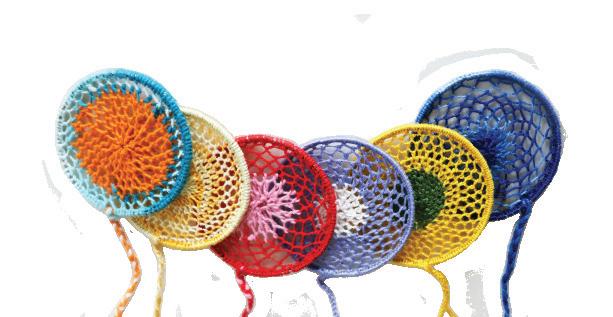
Our
For more information, visit: creeyouthprotectioncommission.ca
or contact us at: 18TCR.CreeYPCommission@ssss.gouv.qc.ca



• In one of the highest profile cases of Indigenous identity appropriation, former judge Mary Ellen Turpel-Lafond was stripped of honourary degrees and removed from the Order of Canada. Controversy later followed similar allegations against beloved musician Buffy Sainte-Marie.
February
• Vanessa Snowboy presents at Dialogue for Life conference in Montreal alongside workshops, healing sessions.
• Clothing designer Scott Wabano makes a big splash at New York Fashion Week after recently co-creating Two Spirits of Eeyou Istchee organization with Geraldine Shecapio and Jomarie Einish.
• Cree riders participate in epic First Nations snowmobiling expedition.
March
• Inaugural Cree Knowledge Festival presents two days of art, storytelling, discussion panels.
• Pope finally repudiates “Doctrine of Discovery”.
• Book launch at Ottawa’s National Gallery of Canada of E nâtamukw miyeyimuwin: Residential School Recovery Stories of the James Bay Cree, illustrated by Cree youth and written by Ruth DyckFehderau, containing 19 accounts from Cree survivors.
April
• Cree leaders discuss conservation, push for representation at United Nations Permanent Forum on Indigenous Issues.
• Cree fighters Quinn Blacksmith and Albert St-Pierre become champions at Montreal Fight League event, hope to establish training facility in Ouje-Bougoumou.
• Danny Pash appointed new president of Cree Construction.
• Cree School Board hosts first ever Post-Secondary Students Services Conference in Ottawa with inspiring speeches, workshops, cultural teachings. “They saw I’m not alone on this edu-
6 the Nation February 23, 2024 www.nationnews.ca
project proudly led by: In collaboration with: PLEASE JOIN US!
A
provide,
nurture our
future is determined by how we protect,
care for and
children.
WEMINDJI
ᐐᒥᓂᒌ
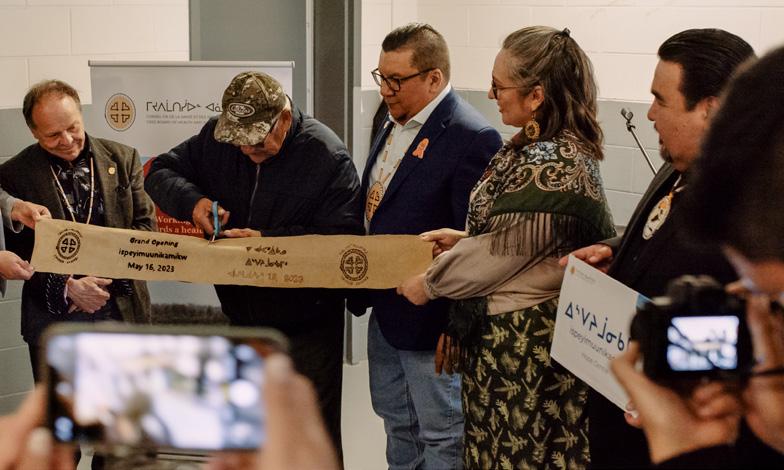
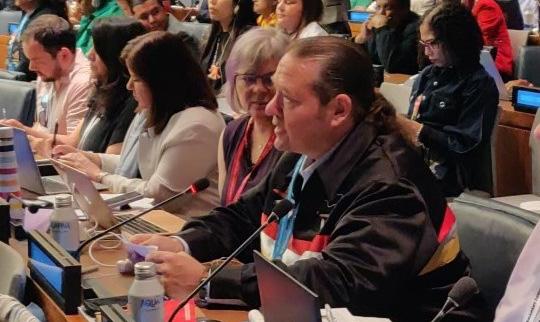
cation path,” said Darryl Diamond, CSB’s post-secondary student affairs technician.
• Cree Women of Eeyou Istchee Association initiates Manchadauu program to help families affected by domestic violence.
May
• Grand opening of Home Dialysis Training Centre and Respiratory Clinic in Waskaganish celebrated as a significant step towards bringing more Cree people with diabetes home to Eeyou Istchee.
• Val-d’Or Native Friendship Centre announces major expansion.
• Premiere of Rezolution Pictures’ Little Bird, a critically acclaimed series executive produced by Ernest Webb.
• First Cree Women Business Conference held in Chisasibi to focus on the region’s growing number of female entrepreneurs.
June to August
• Wildfires dominate summer months, forcing evacuations of many Cree communities beginning with OujeBougoumou on June 6. Ouje Deputy Chief Lance Cooper told Prime Minister Trudeau: “When you and my people go to sleep tonight, our land is still on fire.”
• Smoke from forest fires caused health hazards in Eeyou Istchee and across northeastern North America and radically altered consultations with Quebec’s ministry of natural resources and forests. “The amount of timber that burned in Eeyou Istchee is equal to nine annual forestry plans,” said Waswanipi forestry consultant Allan Saganash.
• Cree communities celebrate National Indigenous Peoples Day June 21.
• Elder Robbie Matthew Sr’s legacy honoured after he passes away.
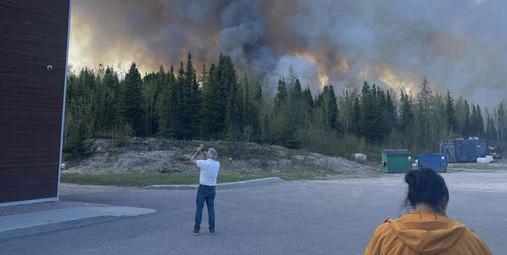
“Today the Cree Nation mourns the loss of its greatest spiritual guide, most tireless cultural advocate and guardian, and wisest mentor to generations of Cree leaders,” stated the Cree Health Board.
• Historic lake sturgeon conservation agreement signed with Fisheries and Oceans Canada.
• Cree athletes impress at North American Indigenous Games in Halifax.
• Indigenous music icon Robbie Robertson, founder of the Band, passes away on August 9.
• Washaw Sibi chooses location near Matagami for future community at special meeting on August 12. “It’s a win-win situation for everyone,” said Chief Annie Mapachee-Salt.
September
• Cree Health Board’s Youth Protection Commission launches public consultations. “Now we have the chance to do what we should have done 45 years ago,” said commissioner Bella Petawabano.
• Grand Chief Mandy Gull-Masty and Cree delegation shares experience about Fort George residential school site investigations at National Gathering on Unmarked Burials. “We become the voice for people who don’t want to talk about it,” said George E. Pachano.
• CNG launches Cabin Damage Assessment Registry.
• Cree entities and communities sign partnership agreement to support Community Miyupimaatisiiun Committees.
October
• Cree Nation shares wildfire stories and other issues in meeting with United Nations High Commissioner for Human Rights. “How big an impact
it has on the Cree way of life has not really been recognized elsewhere,” said CNG justice director Donald Nicholls.
• Chisasibi Resource and Research Institute (CERRI) constructs agriculture research dome.
• Eastmain hosts Annual General Assembly postponed from August due to nearby fires.
• In Manitoba, Wab Kinew becomes Canada’s first Indigenous provincial premier.
November
• Cree Nation Youth Council launches post-secondary tour of Montreal, Ottawa and North Bay.
• Cree Outfitting and Tourism Association’s annual general meeting in Whapmagoostui plans industry’s recovery after fires thwart summer hopes.
• Canadian Rangers conduct training sessions in Nemaska and OujeBougoumou.
December
• Cree School Board announces new Department of Higher Learning. “Ultimately part of our plan is for a Cree CEGEP in our territory,” said director Darlene Cheechoo.
• Cindy Woodhouse elected new national chief of the Assembly of First Nations. “We need infrastructure and all those things maybe Canadians take for granted,” said Woodhouse. “I’d like to hold their feet to the fire to get those gaps closed in a good respectful way.”
• Manon Jeannotte becomes Quebec’s first Indigenous lieutenant-governor. “Maybe I can be a change-maker – this position is significant to Indigenize the system,” Jeannotte told the Nation
www.nationnews.ca February 23, 2024 the Nation 7


International Women's Day!

Let's celebrate the women... in our families, in our communities, in our world!
ᒧᒑᔨᐦᑎᒸᐦᑖᐤ ᐊᓂᒌ ᐄᔅᒀᐅᒡ᙮᙮᙮᙮᙮ ᐊᓂᑎᐦ ᐋᑎ ᐹᐦᐹᔨᑯᑖᐅᓯᔨᐦᒄ, ᒋᑎᐦᑖᐎᓈᐦᒡ, ᑭᔮᐦ ᐅᑎᐦ ᒋᑎᔥᒋᓈᐦᒡ!
Funds for Indigenous job training
The First Nations Human Resources Development Commission of Quebec has received $25 million in federal funds for its Global Strategy for Indigenous Employability project. The project’s objective is to increase the number of Indigenous peoples in employment or vocational training. The project was chosen following an open call for proposals in spring 2022, through the Skills and Partnership Fund (SPF.)
The SPF supports training for jobs in five sectors: green economy, infrastructure, blue economy, information and communications technology, and the Indigenous public sector. Outreach is targeted towards both communities and urban centres. The jobs being promoted exist at the local, regional and national levels.
“When First Nations, Inuit and Métis people thrive, it’s not just your communities that benefit, but the entire country,” said federal Employment Minister Randy Boissonnault in Kahnawake during the January 18 announcement.
Kahnawake Grand Chief Kahsennenhawe Sky-Deer pointed out that previously, the Indigenous labour force in their communities has been
left out of nearby development efforts. “We need to have relations with the First Nations, with the Inuit, with everybody all working together, so that we can raise this profile of where we’re all residing together and ensure that there is equal opportunity,” said Sky-Deer.
The commission, which serves 27 communities and four urban centres, is part of the Assembly of First Natons of Quebec-Labrador.
Power2Overcome conference
The Wiichihiiwewin Centre in Waskaganish hosted the “Power2Overcome” healing conference January 29 to February 1. Knowledge keeper Emily Henry and Elder’s helper Brookie Miller worked as facilitators at the event, which included healing workshops, talk circles and group exercises.
The topic of the first day was exploring personal inter-
generational impacts, whereas the second day covered intergenerational impacts upon families and communities. The third day focused on rebuilding relationships as well as personal resiliency. The final day was a celebration of sobriety, and involved a “sobriety banquet.” Ten people were chosen to participate in the banquet, through a nomination process.
Emcees included Glen B. Whiskeychain and David Cheechoo. The event was run in partnership with the Cree Nation of Waskaganish, the Miyupimaatisiiun Committee, the National Native Alcohol and Drug Abuse Program, the Cree Health Board, and the Healthy Horizons Foundation.
Maqahatine powwow
Maqahatine (meaning “Let’s gather altogether” in Wolastoqey) is hosting a free winter powwow on March 3 (12 noon to 5pm) at 1435 De Bleury in Montreal.
Founded in January 2020, Maqahatine is a multi-genre art collective responding to the need for Indigenous Peoples in the Montreal area to gather and dance during the winter months. Maqahatine welcomes all to their first powwow, to help “keep our winter fires burning” by fostering learning and inspiration within the community.
The organizing committee expressed their excitement, stating, “Join us as we celebrate our many Indigenous cultures, through our songs, dances, and beautiful art. Powwows are a powerful gathering where multiple communities and generations of people come together to witness the pride of Indigenous people. Maqahatine is meant to be a place of sharing and education; education that comes from the community itself.”
Please note that boots are not allowed inside the space, so bring shoes, slippers or socks.


www.nationnews.ca February 23, 2024 the Nation 9 In Brief In Brief




SPORT LANGUAGE &

10 the Nation
Features February 23, 2024 www.nationnews.ca

Annual Waskaganish Hockey and Broomball tournament
by Josh Janke
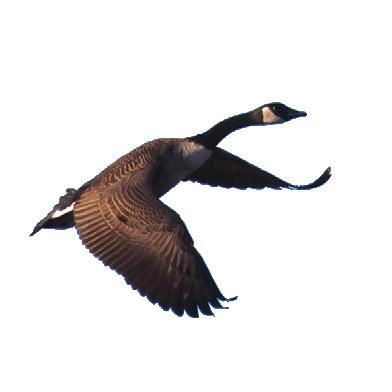


 Photos by Johnathan Levert of Nomad Productions
Photos by Johnathan Levert of Nomad Productions
The Waskaganish Wings were the hometown heroes this month, winning the Class A final in the 35th Annual Waskaganish hockey and broomball tournament. Led by the Hester Brothers, Alex #89 and Brett #69, the Wings showcased hockey heart and hustle at its finest. After prevailing in a dramatic semifinal that saw the Wings down 3-1 only to come roaring back to score 3 unanswered goals enroute to a 4-3 overtime victory. The Wings surged into the final with this momentum, finishing off the tournament in wild fashion with an 8-1 blowout that stuffed the stat sheet and delighted hometown fans. With the tournament win, the Wings maintained home-ice advantage, securing the $18,000 Class A cash prize and bragging rights until next year.
The Nation spoke with Tournament organizer and proud father, Charles J. Hester, who surprised Cree hockey players and fans by hiring his friend, Johanthan Levert from Image Nomade Productions, to capture all the action from the action-filled weekend. “I worked with Johnathan’s dad, he used to come up and work on the phone lines,” said Hester, explaining how he first met Johnathan. We’ve been in connection for a long time since then, Johnathan is exceptional at his craft. We agreed to make this tournament extra special and memorable for all.”
Hester, who was in Montreal to take in some NHL action before the tournament, announced via his Facebook that this year, a professional photographer and complete livestream with play-by-play commentary by Hester himself would be bringing Cree hockey one step closer to the big leagues. “It was great, I told players to send me the time of their game, their team and jersey number so we could get specific shots. I told them that all they have to do is play fast and hard and we will
LANGUAGE OUR NEW ADDRESS 4200 Boul. St. Laurent, #918 Montreal, QC H2W 2R2 514-272-3077 info@beesum.com beesum.com
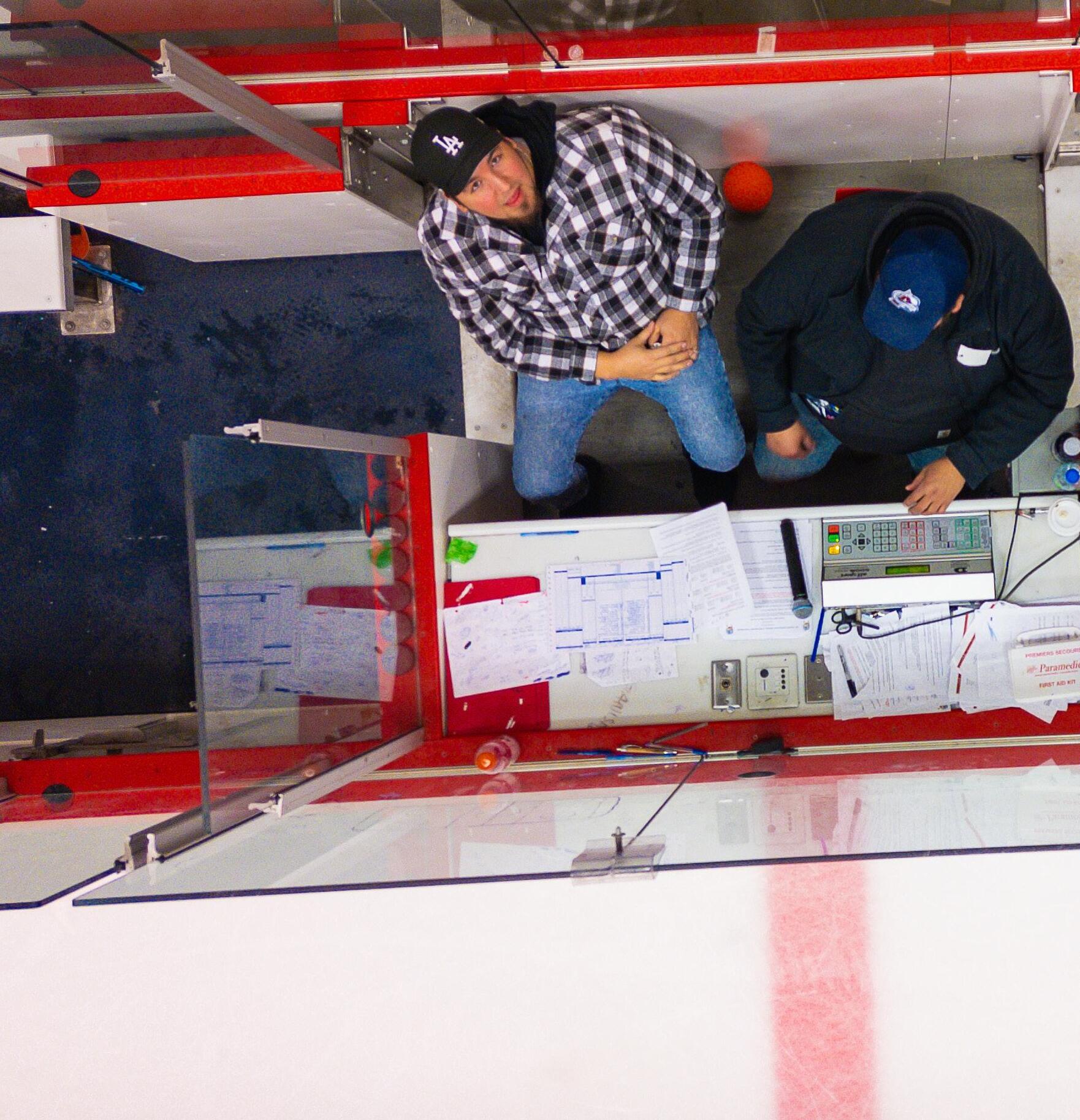
find you. No one is ever too fast for the camera!”
“It gives a lot of especially with the photos, the live stream, the commentating. It brings it to another level, and these are good players, its high-level hockey. the other communities responded well, there were many grandparents and community members who had expressed a desire to watch the games despite not being able to make the drive to Waskaganish.”

Nation. I don’t want to just watch a game of hockey; I want to play.” “Hockey is a family thing for us, I got 8 boys and six of them have already played in the tournament. The two youngest ones are still in minor hockey. Organizing events like this, it doesn’t even feel like work for me.”

nection point where learning can occur more easily because it just feels natural and fun.”

Not only did Hester organize and commentate the games, but he also laced up the skates to play in the tournament’s recreation division. “It was tempting to watch another Habs game, but I decided to head back home,” Hester told the

Commentating in the Cree language is what really brings the community together in the long run Hester says, because hockey and broomball are natural connection points between both family generations and Cree communities. “I try my best to do all in our language. There are so many kids playing hockey here, everyone knows hockey in some way or another, so it becomes a cultural con-

Hester says that every language is in danger because there is always the possibility that people will stop using it in favour of another. He sees hockey as a part of the solution for language loss in Eeyou Istchee because its an easy introduction. “I can see that less of the young people are speaking it. One of my sons, he understands me when I speak our language but he still replies in English. I tell him that if he doesn’t use it himself, he will lose it. I am just putting my words into action, and what’s better than hockey action?”

February 23

Tournament Results
Final Class A
Champions: Waskaganish Wings
Finalists: Chisasibi Hunters
Final A-Broomball
Champion: Wemindji Ice Stars
Finalist: Eastmain Angels
Tournament Results
Final Class A
Final B-Broomball
Champions : Waskaganish
Champion: Wemindji Crees
Finalists : Chisasibi
Final A-Broomball
Finalist: Chisasibi Scorpions
Champion: Wemindji
Finalist: Eastmain
Final B Broomball
Champion: Wemindji
Final Recreational Hockey
Finalist: Chisasibi
Champion: Chisasibi
Final Recreational Champion: Chisasibi
Finalist: Waskaganish Raiders
Finalist: Waskaganish
Women Hockey Final
Champion: Mistissini Mustangs
Finalist: Ouje Lady Hawks


Hester sees it as a marriage of sport and language, allowing the Cree language to ambassador this active connection point that the community knows so well. All the kids are excited about hockey, and this excitement transferred to language when I was commentating,” Hester said. “It was interesting having to create Cree translations for English hockey slang like offside and icing,” he said, explaining how the word he created translates in English to something like ‘when the puck goes all the way across the pond’. “I think that makes more sense than ‘icing’ anyways, Hester said with a laugh, “The audience loved it.”

Overall, the tournament reached nearly 200,000 people and Nearly 60,000 people viewed the livestream broadcast. That’s a lot of people that got to hear the Cree Language in their living rooms or handheld devices. The fans also filled up the arena, giving an electric atmosphere that could be heard over Hester’s broadcasting. “The building was packed; it was loud man. One of those moments where everything builds on each other and everyone’s hard work shows. You can’t organize an event alone like that.”


The tournament was also made possible by numerous sponsors from in and around the community – the Waskaganish Youth Council, Gordon’s

Canteen, Blackned Construction, and Blackned Essence were the tournament’s Major Sponsors, while the Waskaganish Youth Department, Smokey Hill Grocery Store. Googoo;s K’s, Siibii Radio, and Waska Resources all made Gold Level sponsorships. “Believe me, I know how boring it can be to play in an empty venue. Thanks to the fans, master of ceremonies, DJs, referees, coaches, and first responders who all made this possible, you all expressed great excitement, safety, and sportsmanship this weekend. This is a success that we all played a part in, both on or off the ice.”






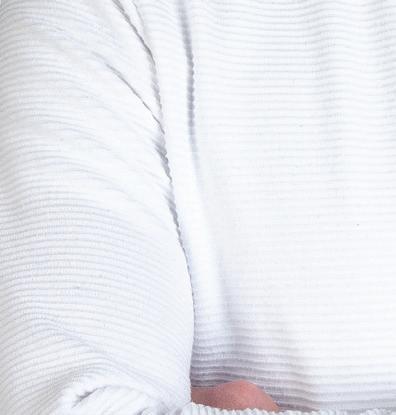



















14 the Nation February 23, 2024 www.nationnews.ca ouwahstore@gmail.com www.ouwahstore.com (514) 588-3162 18 Fort-George Road ᒥᓯᐙ ᒥᔻᔨᐦᑎᐦᑖᐤ ᐋ ᐙᒋᔮᒥᐦᑯᒡ ᐋ ᒥᔅᑳᑖᔮᔨᐦᑖᑯᓯᒡ ᐄᔅᒀᐅᒡ! ᒋᐦᑳᓈᑯᓯᒄᐦ ᒨᔥ᙮᙮᙮᙮ ᓂᒧᐎ ᒥᒄ ᐆ ᐊᓅᐦᒡ ᑳᔑᑳᒡ ᑭᔮᐦ ᐊᔑᑯᒻ ᒋᔑᑳᐤ!
Women's Day
Happy





WINTER ACTIVE Be Let’s Build a Strong and Healthy Cree Nation For more information about Winter Active across Eeyou Istchee, contact: WALLY RABBITSKIN PPRO Physical Activity, Public Health (CBHSSJB) Phone: 418-923-3355(x42365) Cell: 418-770-3975 wrabbitskin@ssss.gouv.qc.ca JANUARY TO MARCH 2024 ENJOY THE OUTDOORS WITH FAMILY AND FRIENDS Physical activity helps us physically, mentally, emotionally, and spiritually creehealth.org/winteractive
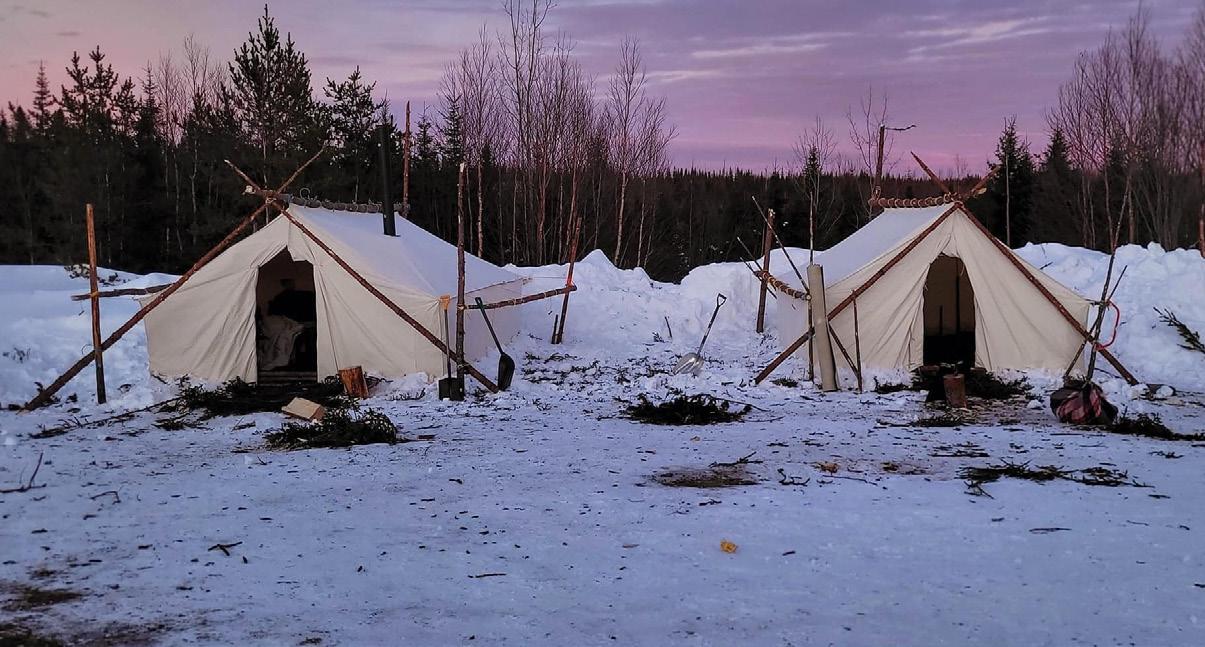
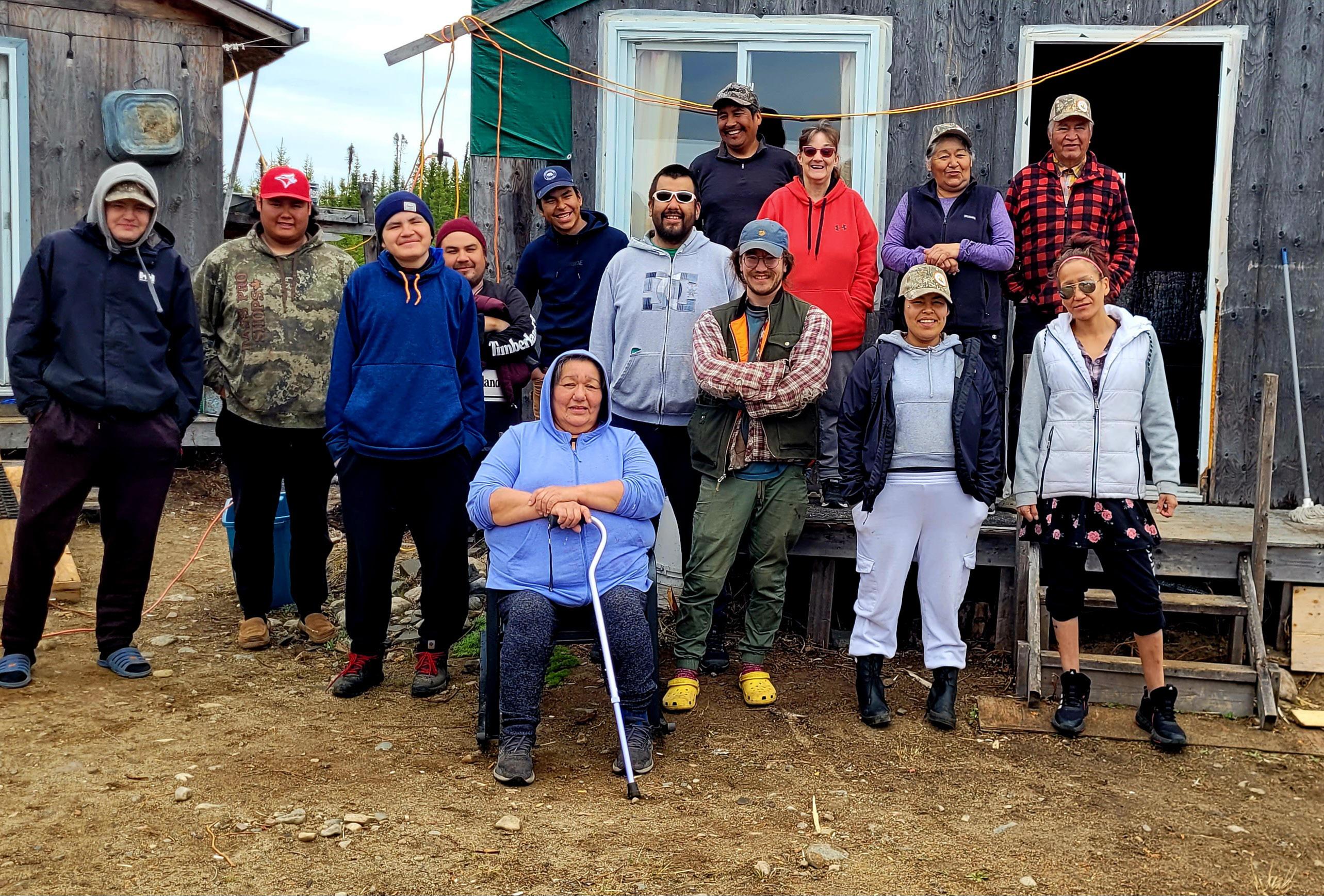

LearningKnowledge CREE
by Patrick Quinn, Local Journalism Initiative Reporter

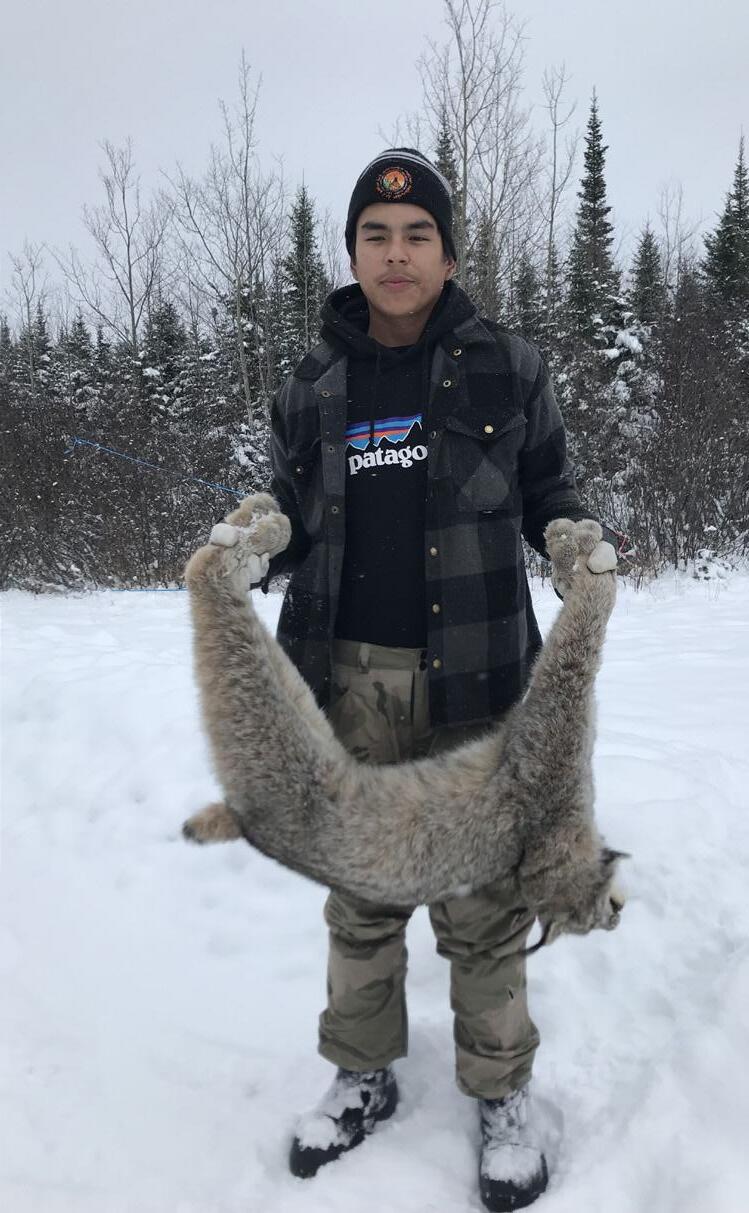
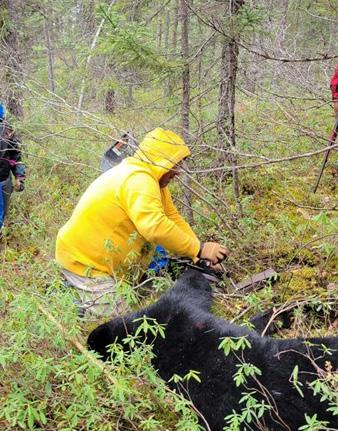


Eeyou Ituun program graduates second cohort
The second cohort of the Eeyou Ituun (Cree knowledge) program graduated in Mistissini on January 29. The nine-month, 900-hour program was created by the Cree Trappers’ Association, the Niskamoon Corporation and the Cégep de St-Félicien to teach fundamentals of the Cree traditional lifestyle and living off the land.
While most of the nine graduates from different Cree communities were around age 20, the class also included some in their mid-30s and 64-year-old Sophie Coonishish Gunner. As a residential school survivor, Coonishish Gunner said it was important for her to learn culture knowledge she missed out on while attending school away from home.
“Sophie was there for the same reason that I was,” said fellow graduate Tyra Angel Tanoush-Fleming. “I’m there to learn my culture. It’s a great experience and you’ll love being out there learning a lot of different things you did not know. The Cree way of life is a sight to see.”
In development since 2014, the Eeyou Ituun program was initially planned to launch in early 2020 but was delayed by the Covid pandemic until September 2021. The CTA worked with Elders to determine the 15 competencies to be achieved, while St-Félicien pedagogical counsellor François Payette designed the syllabus and validated achievements.
Elders and tallymen do most of the teaching and course building and are compensated by the college equivalent to a teacher with a PhD. Payette will consult with them to clarify where they are in the program, informing them whether any guest speakers are invited and ensuring that all core competencies are eventually completed.
“Sometimes we’ll go to a Cree camp and the Elder will say we’re going ice fishing and setting nets and I’ll have to say we already done nets four times,” explained Payette. “Sometimes it’s a little tricky because some competencies have already been achieved and we need to work on the other ones.”
Payette estimated that 60% of Eeyou Ituun content teaches skills such as camp building, crafting tools and harvesting. Other parts are more science-based, including checking for ticks on moose hide, watching for diseased fish by comparing with reference books, or testing walleye bones at the lab to determine a specimen’s age.
Recent guest speakers included biologists from the ministry of natural resources (MRNF) and the CNG’s Nadia Saganash and John Paul Murdoch to discuss land-use negotiations. While there is spreadsheet work to inventory harvest details and certain tasks to complete with tools like GPS, most evaluation is done through individual meetings and observing students in action.
“We take the students where they are when they arrive and want to bring them further,” Payette told the Nation. “It’s individual goals. Students can’t be a tallyman in nine months – we want to build a toolbox so they know a little of everything that they can build from.”
Whereas the first cohort was based in Waskaganish with much classwork held in the community, this time all the training was done at various traplines in Mistissini, Waswanipi, Ouje-Bougomou and Wemindji. The course was divided into nine blocks of two or three weeks at camps, with a week or two off in between.
Without the distractions of modern life, students could better focus on the many tasks of camp management, such as securing sufficient water and firewood. A counsellor would provide occasional guidance and days would end with a sharing circle. While there were chilly nights and cold showers, students enjoyed being immersed in the traditional Cree lifestyle.
“I enjoyed my time in the bush staying in my prospector tent,” said TanoushFleming. “I wish I could have stayed longer in the program – it passed by so fast.”
Others also suggested extending the program, even joking they wanted to quit so they could sign up again next year. Teachings from Elders like Abraham Etapp or Anna and David Bosum were recognized as particularly precious, illuminating bush knowledge, ancestral leg-
ends and a way of life from before the time of residential schools.
“I enjoyed their stories, what they went through and how the Elders view the land,” Tanoush-Fleming said. “It made me realize there’s a lot more material on the land we can use. In the past, we didn’t have ropes, so we used the roots of tree stumps to tie up a canoe or something.”
In teachings such as gutting a bear, students would be shown the entire process before trying it on their own, helping each other when someone forgot a step. When some students treated the program like a vacation, Tanoush-Fleming would focus on her own work, reflecting that “you’re there to learn what you want to learn.”
As an accredited program, Eeyou Ituun graduates earn an Attestation of College Studies diploma from the Cégep. Completion certificates were also given for individual courses so students could finish the program with résumé-boosting certificates in boat driving, bush kit training and gun safety.
Some of this year’s grads are interested in a new Cree Wildlife Protection Officer course launching at the college in August. Over 1,300 hours at Chibougamau and Cree traplines, students will learn material such as poaching investigations, land inspections and crisis management. The program responds to an urgent need for Eeyou Istchee Land Keepers and prepares students for similar game warden positions across the province.
While previous students have found jobs with the MRNF taking moose inventory in Zone 22 and coordinating a youth program at Mistissini’s Murray Lodge, some proceeded to studies like accounting. Working for the new Canadian Rangers junior patrol in Ouje-Bougoumou, Tanoush-Fleming said she looks forward to passing on the teachings she learned to new recruits.
“One of our teachers, Abel Jolly, showed us how to make a shelter when you’re stranded in the woods,” TanoushFleming recalled. “I’ve been making that here and there sometimes. I’ve been going out on the land on my own time now since the program ended, setting rabbit snares and marten traps – I just got one this morning.”
www.nationnews.ca February 23, 2024 the Nation 17

STATE OF THE
The Grand Chief reviews the year 2023 in Eeyou Istchee
Photos provided by Flora Weistche
Interview conducted by Avanti Nambiar
2023 was a difficult year.
The summer months were disrupted by forest fires that raged across Eeeyou Istchee and uprooted the lives of many. Plans and projects were put on hold as survival became the main priority.
At the helm of the Cree Nation Government, Grand Chief Mandy GullMasty worked tirelessly with all the communities to oversee this collaborative response.
The Nation asked the Grand Chief about the successes and challenges of last year as well as the government’s future plans, in our annual State of the Cree Nation address.
The Nation: How would you describe the current state of the Cree Nation?
Grand Chief: We’ve seen a lot of evolution between 2023 and 2024. One of the interesting things that we’re working hard on is our relationships with other Indigenous nations. We hosted the Innu nation in the community of Chisasibi and it was really productive, one of the first of its kind in Canada, where one nation meets another nation to do a trade: we had to reduce the number of caribou that the Innu nation was able to harvest.
This is one of the foundational aspects of this relationship, a trade of caribou. Due to the impact of this past summer’s forest fires on the caribou and their habitat, we are trying to be very conservative in managing our impacts on the territory. I’m hopeful that other Cree Nation members are following this trend, where they’re being mindful of their harvest impact.
Our relationship with the government of Quebec is a huge working file for Cree
Nation. There’s a lot of focus and energy put towards working with our partners. I want Cree Nation members to understand is that there are so many different ways that we work with Quebec, in terms of governance, in terms of relationship, economic, social… We work with almost every single ministry. Last year, I’ve seen some ministries really succeed in working with the Cree Nation. But I’ve seen others that are really challenged. And 2024 will probably be the year where some of these files are going to be heard by the community members at the Cree Nation Council board table. It’s an incredibly challenging job.
There’s going to be some issues that come to the table that will probably be challenging for the Crees. And for me right now, one of the huge challenges is what happened this past summer. The forest fires had a tremendous effect on the Cree Nation, not just in terms of land loss, but on people who were evacuated and taken from their communities. Loss of time, loss of employment, loss of revenue – not to mention the impact on tallymen and land users who lost their equipment, lost their cabins. Some traplines were devastated by forest fire, up to 90%.
These things have had a huge impact on the Cree Nation. We’ve spent a lot of time after the summer trying to catch up on the issues that we were working on. Everything was at a standstill. We’re hoping to bring forward more solutions in 2024. And we’re not only looking to bring solutions internally from the Cree Nation Government, but we’re also looking to engage our partners at the provincial and federal levels to address what happened on our territory.
The Nation: How did the Cree Nation handle public health challenges this year?
Grand Chief: This past summer was something that was so out of the norm. We do have emergency planning in the communities, but for the first time in our history, we had to have regional emergency planning. This is something that was a challenge, because our territory is so large, and there are different organizations that manage different parts of the territory. The communities are Category One: they’re managed by the communities. Category Two is managed by Cree Nation Government. Category Three is managed in collaboration, by the Cree Nation Government and the regional governments of Eeyou Istchee.
This summer was a test of those working relationships, because we were suddenly required to come together and come up with these super important strategies in response to an emergency. How to manage resources or territory; how to deal with sudden evacuations.
It’s important for people to understand that in Eeyou Istchee the are multiple levels of government that work together. We have different mandates. There’s a successful working relationship. We were able to get through the fire season without anybody being harmed. Without any Crees losing their lives. I think that’s really important to focus on.
We’re still studying the level of impact that it’s had on the territory, what happened with evacuations, the response time. It has highlighted a new area of governance that wasn’t well defined. We’ve come up with a lot of protocols since. We’re going to be tabling a final report at a
18 the Nation February 23, 2024 www.nationnews.ca Politics
THE NATION

regional government meeting about how things went during this period of time. How did people work together? We had some staff members who were working on this nonstop.
Our deputy executive director, Melissa Saganash, did an incredible job in bringing these different levels of government together to find solutions. There were many people who did a lot of planning behind the scenes and it was really challenging because it was so unprecedented. I think the government of Quebec realized how unprepared it was, and that it had a major lack of resources. Quebec was really not able to fight the fires.
For me, this is one of the challenges for Nordic regions. They have different levels of priority when they fight fires. And unfortunately, we fell outside of those regulations, and we suffered a lot of impacts because of them. I think that Quebec needs to reassess and realign its procedures to address the needs of people who are impacted by fire.
We are already looking at the 2024 summer season. The predictions from the Canadian Forest Service are saying that it’s going to be a very dry year. There’s an extremely high risk to have forest fires again. So our priority as a government is to ensure we have better emergency planning. That there are more mechanisms in place to respond and fight fires.
It’s also going to take the collaboration of our Cree Nation members. They need to plan for fire resiliency, fire prevention, at their campsites. To take the time to make sure that their camp is not going to be at risk of fire, buying insurance, making sure that they clean up around their camp, pulling away the
brush, gettng rid of any root systems that are near their camp in order to create a little fire barrier. These things are really important. What saved a lot of people’s cabins is that some of them had fire resiliency.
These are the kinds of things that you will be hearing from the Cree Nation Government. In the next couple of months, you’ll have information about the cabin program, who will be eligible, how will this program be rolled out. What are recommendations that we’re giving for this summer, how to be prepared, how to focus on spring activities to get their camps ready for the summer.
The Nation: What were other big issues for the Cree Nation Government to work through?
Grand Chief: Cree Nation members have been seeing a lot of activity in the mining sector. And I’ve noticed that people have a lot of questions. I encourage people to attend events, community consultations, or when companies come to do presentations. It’s really important to be informed.
When the company comes to Cree Nation territory and they’re pursuing the project, we have a huge role to play. One of the most important is the land user and the tallyman and his family members who make use of that trapline. They have to be informed. They have to be aware of the decision making that the community makes in this process. And then there’s the Cree Nation at the table. Having oversight for environmental assessment, having participation at the negotiation, helping the communities understand what the project is about.
When a community chooses to accept a project in their territory, there’s a lot of work put into that. I am mindful that we need to create employment opportunities. And we use the lens of sustainable development, to take care of the territory and leave impacts that can be managed. It’s a challenge to walk that line. But I do think that the communities that have active mining projects in their territory have gone above and beyond. Sometimes, it’s a really successful working relationship. Sometimes there are challenges in the process.
But there is a lot of responsibility for the Cree Nation, to make sure that we are involved, that we’re informed, that we are aware of the steps, and that we are providing that social acceptability. And that is probably one of the greatest tools that the Cree Nation has. Not only the environmental assessment authority that we have under the James Bay and Northern Quebec Agreement. We are really able to be drivers of what our expectations are of the project, and what the success is for it.
In 2023, I had the opportunity to go with the Government of Canada to an investment conference in London. I was able to showcase how we operate as a nation, how our mining files are handled in the territory. We’re quite unique. I feel that we’re very advanced in the way that we present ourselves in the mining domain and how we want companies to work in our territory. We have a really good system, but we always have to strive to be better. So we’re taking feedback. We are looking at the relationships between companies, we’re looking at how tallymen are looking at projects in
www.nationnews.ca February 23, 2024 the Nation 19
STATE OF THE NATION
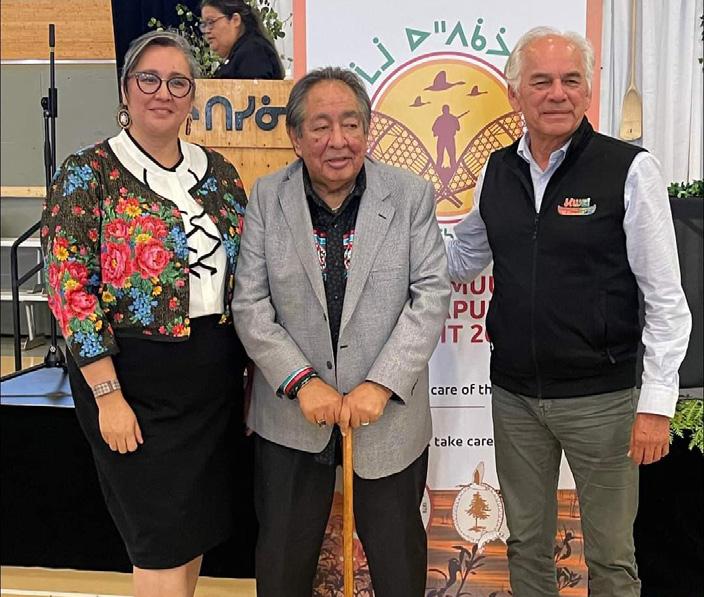
their territory, and we’re incorporating it into how we do our work.
This is one of the big files that you’ll see coming up in 2024. You’ll see a lot of dialogue on energy. I think many Quebecers are aware that Hydro-Québec released a huge strategic action plan. And that plan does involve the Cree territory as well.
The Nation: What are some of the lessons you will be taking forward?
Grand Chief: I’ll call it more of a learning curve for me, and the members of the council board. I am the Grand Chief, I am the chair of the Cree Nation Government table. But our government operates with additional community leadership, community chiefs, community reps, they have a role to play in our governance cycle. And this year, I am so proud to see that half of the community chiefs are females. It’s something that’s really important, that you see a huge participation of women in the governance system. I’s created a new dynamic at the Cree Nation Government table. I would say that, out of the 11 chiefs who sit there, eight are newly elected leadership.
You’re also trying to engage them and understand their different styles. You’re trying to help them with their community, trying to have open dialogue. This is one of my leadership lessons: how can I help others understand their roles, encourage them, work with them, and empower them. I’m always excited to see new people coming to the table. And I’m looking forward to seeing what they want to bring to the communities.
The Nation: Economically, how has 2023 been for the Cree?
Grand Chief: Economically, the Cree Nation is in a position where it has secured a lot of funding. We do see that there is a greater need for a more focused
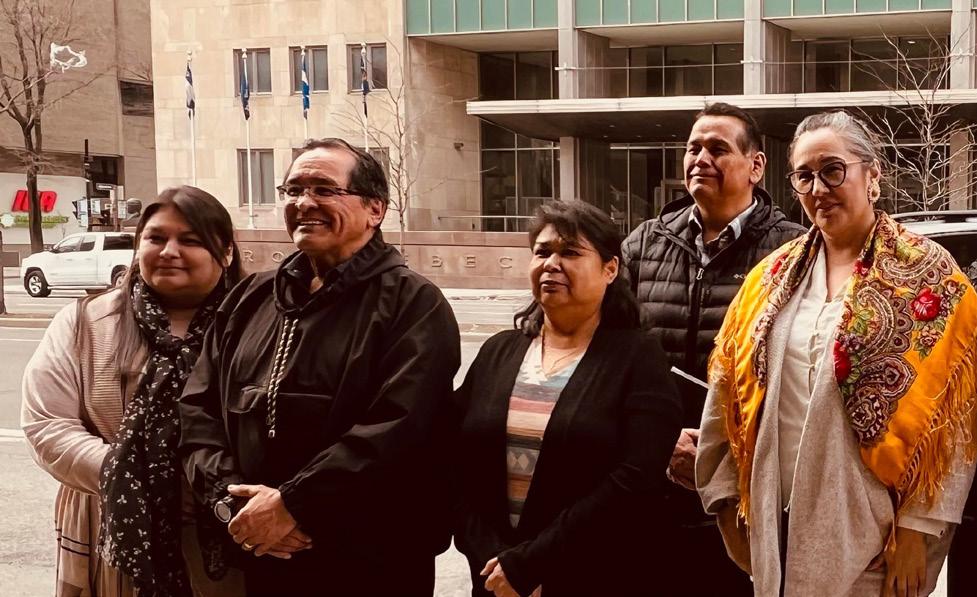
lens on a Cree economy. This past summer was so hard because there were a lot of things that stalled. It gave us the ability to reflect a lot and to ask, “How has this event made us realize things about our working relationships, our territory, our needs, as a nation?”
We just came out of two huge events: the Covid pandemic, and then the forest fires. It’s made us realize the importance of driving a Cree economy.
I’ll give you a little bit of a scoop. Every year, we do a declaration with our partners at the Cree Health Board and Cree School Board. This year, it’s going to be a declaration of strategic initiatives that contribute to economic development. It’s a strategic alignment of how we can use our funds to enhance or create new economic opportunities. How communities can plan together. How to enhance regional planning, how to incorporate initiatives that make the greatest impact.
You’re also going to see a lot of planning coming out of our Department of Commerce and Industry, because they’re huge drivers in the economic sector, about how we as a nation can use our funds to create a private economy. We have a strong public sector, but we need to enhance that private economy. And it is our opportunity as public entities or public associations to spend our money building our relationships with private sector entrepreneurs.
We’re looking to support entrepreneurs. We’re looking to bring information to our members: to explain to them what does the Cree economy look like? What are the foundations? And what are its components? Where are we strong? But also, where are we weak? And what should expect?
The Nation: What were the successes for the Cree Nation Government in 2023?
Grand Chief: I want to highlight the work of the Deputy Grand Chief [Norman Wapachee]. It’s important for members to be aware of the work that he’s doing. At the moment he’s working on the cultural baseline study, looking at the state of culture and the territory and evaluating how it has changed, how it has shifted. This is really important information.
We discussed this at the beginning of the term. This is a priority for us, to understand the state of culture, the state of language, it was one of the pillars of my platform. I was so glad that he was able to undertake this project and to really drive it. That has also branched off into a Cree Nation Research Institute. We are often the subject of study, we have a lot of different organizations that come into the territory and study aspects of our culture. And it’s really important for us to drive those research initiatives.
So he’s setting up an organization that will allow for us to not only actively participate in research initiatives, but to become the owners of that data. And I’m really proud of the work that he’s doing. He has been such a huge support to my office.
He’s been handling a National Marine Conservation Area file. Working on trying to establish a zone of protection for the James Bay, not only for Cree territory, but also in partnership with our neighbours in the north, the Inuit. So you’re going to see this one coming to the Cree Nation table again in 2024. There will be more public discussion about how communities on the coast can understand and prepare for a protected area in their coastal waters.
He’s done an exceptional job. And I’m looking forward to seeing how 2024 is going to unfold.
The Nation: What is your current relationship with the federal and provincial governments?
20 the Nation February 23, 2024 www.nationnews.ca

Grand Chief: At the federal level, 2024 is going to be a year you will start seeing some movement. We’re expecting an election soon. On the federal level, we have a good working relationship with the government. We have files that we are advancing. We had a lot of success with the housing negotiations, we’ve had a lot of housing go up.
But what the Cree Nation has to prepare for is that soon some of our agreements will need to be renegotiated. There’s going to be a lot of work. There’s already work that’s starting internally to evaluate the implementation and how we can further enhance those agreements. We’ve taken over responsibilities from these governments. So we have to evaluate that work. We have to make sure that we were able to achieve what was outlined in these agreements. That we’ve implemented them to the best of our capacity. And if we haven’t, we have to explain to the government what our expectations are, and our needs to address.
I’m also keeping my eye on what’s happening in Ottawa. I always seek to understand and listen to what the different parties are doing. I had the opportunity in 2023 to participate in a few Senate committee hearings. I was excited to learn about the efforts of Senator Michelle Odette in creating a national reconciliation table. That is really forward thinking, that engages different bodies to come to the table and talk about reconciliation. We have to do our part in participating as well. This is important for me as a grand chief, that we are enhancing our relationships with other nations. That’s a huge part of our role.
I was excited to see the election of Cindy Woodhouse [as National Grand Chief]. I’m looking forward to working with her. I’ve known her through our work with the Vatican, and with the Pope and his visit.
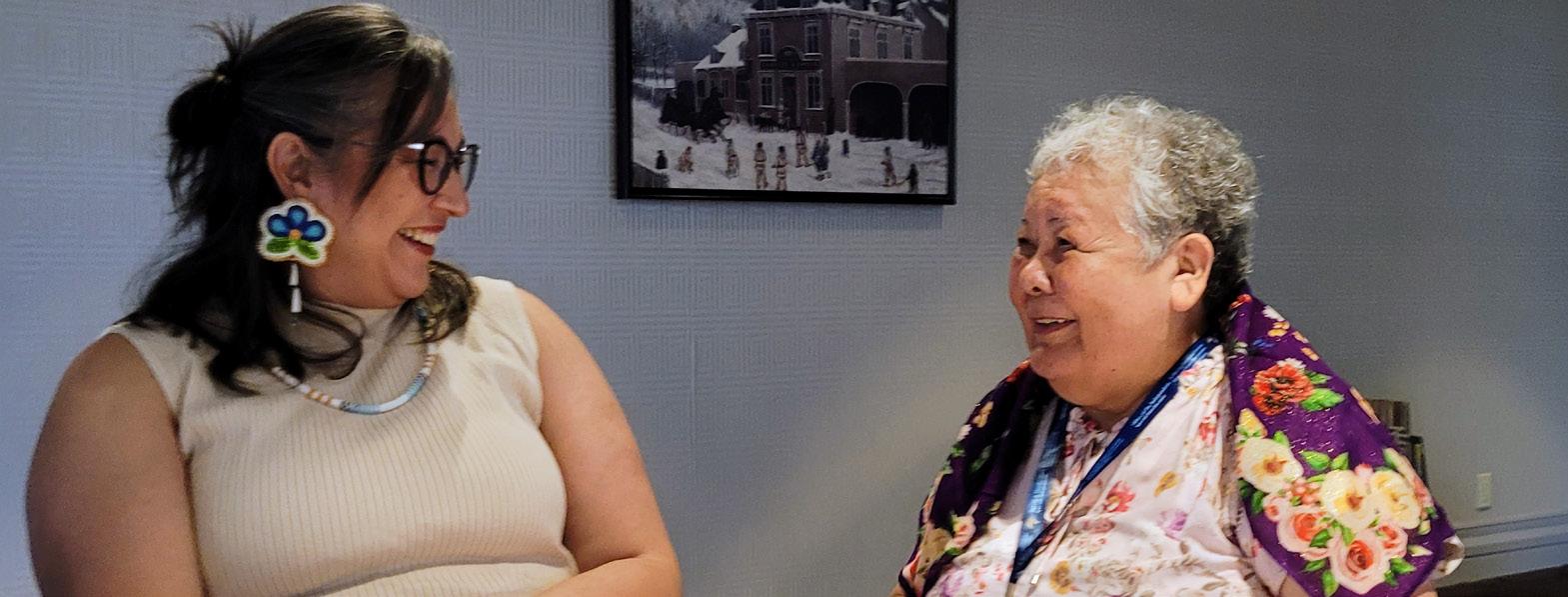
In terms of Quebec, this is probably where my energies will be focused. Our primary relationship is with the government of Quebec. Some things are going really well. Some things are a bit more challenged. And it’s because our partner understands that they need to make better decisions.
I will be pushing very hard for Quebec to adhere and to make good on their responsibilities to us. In some areas, I’ve had to grade the government of Quebec’s performance very low. I want to be clear: we have a partnership, we have a working relationship. We have put a lot of effort into maintaining good relations.
There has to be more clarity on Quebec’s part in understanding what their role is in a relationship with us. Because we are a key partner, and we’ve had a lot of successes. So it’s important for Quebec to engage with us right now. I am looking for a better performance from some of the ministries. Some are doing really well but others are struggling. So this will be an area where a lot of energy needs to be put forward by the Cree Nation.
The Nation: How has the relationship between the Cree Nation and other Indigenous leadership evolved?
Grand Chief: One of my goals as Grand Chief was to try to build these relationships with our neighbouring nations and with other nations throughout Quebec. So I feel that we’ve had a very successful relationship with the Innu nation to the east of us. We’re very closely related. We also signed an MOU to have a permit form with the Inuit and the Naskapi.
One of the huge priorities is to connect with and have dialogue with the Moose Cree. This is a file that has been very challenging for previous leadership. I feel that there’s a lot of things that are not clear, in
terms of understanding the position of the Cree Nation.
I’m really happy that Chief Peter Wesley’s office has stated that he’s looking to hear from the Cree Nation and understand what our position is. So I’m excited to connect with them. I hope to build a good working relationship with them. They are our closest relatives, and I want to be allies with them. I’m hoping that 2024 is going to be the year that this will be achieved.
We are also working with other nations across Quebec. I’ve had the opportunity this past year to work with the AFNQL table, we do support many of their files. We as the Cree Nation have different mechanisms that we use because of the JBNQA. But I appreciate going to those other leaders who are interesting, and dynamic. They have different approaches. So you’ll see more of this engagement coming from the Cree Nation.
Relationship building is hard, you have to put a lot of time into it. And you have to try to be open, and you have to try to understand what it is that you’re looking for. And that connection across Indigenous nations in Quebec is really important for us.
The Nation: What can Crees expect from the Cree Nation Government in 2024?
Grand Chief: In 2024, there are two files that will be big topics of discussion and movement. We have seen from Quebec, the release of their strategic plan. We’ve been having a lot of discussions with Quebec. What is their intention for the Cree territory?
I sense from Cree Nation members a nervousness. We’ve had a lot of trauma from the development in our territory, so there’s a lot of concern. I do want to reassure the Cree Nation members that we have made our messaging very clear
www.nationnews.ca February 23, 2024 the Nation 21
A NEW BRIDGE TO A UNIVERSITY EDUCATION
PUBLIC NOTICE
Ministère des Ressources naturelles et des Forêts
PUBLIC CONSULTATION – SPECIAL MANAGEMENT PLAN IN THE NORD-DU-QUÉBEC REGION
From February 26 to March 21, 2024
The ministère des Ressources naturelles et des Forêts (MRNF) invites the public to participate in a public consultation on the special management plan of the forest fire 467 located in management unit 086-66 of the Nord-du-Québec region. The special management plan shows some areas affected by the forest fires in the summer of 2023, where more urgent timber recovery is planned. Where necessary, work to regenerate the forest is also planned.
Interested in studying business, engineering, or psychology but still need courses to get in?
The Kaié:ri Nikawerà:ke Indigenous Bridging Program is for you!
Join a supportive Indigenous community while completing the prerequisite courses needed and developing skills for long-term success. All students will receive an entrance award of up to $5000.
Learn more at an upcoming info session at concordia.ca/indigenousbridging

To consult the plan and submit your comments: Québec.ca/consultations-foret-nord-du-québec

You have until March 21, 2024, at 11:59 pm, to provide your comments.
INFORMATION ACTIVITIES
Departmental experts will hold an information session to specify the areas for potential intervention for public consultation, the way to provide online comments, and the followup that will be done regarding addressed concerns. A question-and-answer period with participants will conclude the activity.
Management unit 086-66 : Tuesday, March 5, 2024, starting from 6:30 p.m.Matagami: EIJBRG Headquarters – Large room (2, rue des Rapides)
FOR MORE INFORMATION
Specialists are also available from Monday to Friday from 8:30 a.m. to 12:00 p.m. and from 1:00 p.m. to 4:30 p.m. using the following contact information:
By email: nord-du-quebec.foret@mrnf.gouv.qc.ca
Unité de gestion de l’Harricana-Nord 1122, route 111 Est
Amos (Québec) J9T 1N1
Telephone: 819-444-5238
Note: This consultation does not allow for the review of the use of public land, or the rights granted to it.
Date de parution : 23 février 2024
THE NATION
that there has to be no further development of dams in the Cree territory. This is not something that we’re open to, we’ve made our position clear to Quebec.
They have also come to the table and said, “No, we are not looking to further develop dams in the territory.” It’s been 60 years since we’ve signed the JBNQA. This means that a lot of the infrastructure on the territory is quite aged. So you will see dialogue between the Cree and Hydro-Québec, and discussing how they are going to be managing the upgrades or managing the maintenance of that infrastructure. This is really the only area that we’re going to be looking at in terms of what dams exist in the territory, and how are they going to be maintained and upgraded so that they’re more efficient.
No new dams, but the infrastructure itself as a point of discussion between Cree Nation, the communities, and Hydro-Québec. So we’ve been exchanging for over a year, you’re going to see some of these things coming forward early in the new year. And what the Cree Nation’s plan is going to be for energy in the territory.
We are all aware of the impact of climate, we are all aware of how important energy is for the province of Quebec, and also for the Cree Nation. We are looking to not only enhance our information campaigns around efficiency and the use of energy, but we’re also looking at evaluating how do we, as the Cree Nation, use energy? And what can we do to contribute to the efficient use of energy in the territory?
The Strategic Action Plan is a public document. If people wish to read it, it is available online. We are involved in looking at “What is this energy planning for the Cree Nation?
And how can we create a Cree Nation driven energy plan that’s going to be sustainable, and to be mindful of how we can take care of our territory in the future?” I’m glad that the communities have been engaged in this process.
The Nation: Is there anything else you’d like to add?
Grand Chief: I want Cree Nation members to know that this year, we are working on our Leadership Conference for women. We’re partnering with HEC Montréal to create a leadership forum for women in March. I want to thank the Cree women of Eeyou Istchee for prepping to partner with us and hosting this event.
And I’m excited to see these discussions with women on their leadership and where they’re going with it, encouraging women to engage in leadership opportunities, or community governance opportunities or representation in any area, and trying to understand what they’ve learned and what it is they’re looking for, to enhance their skills.
In closing, for 2024, I want to wish each of the Cree Nation members a Happy New Year. All of the blessings for family and health and community to every household in the Cree Nation. Because it’s important for us to reflect on how far we have come as a nation. We’re going to see the 60th anniversary of an historic document that has allowed us to become the nation that we are.
I want everybody to understand that we each have a part to play, every single member of the Cree Nation. We have to be involved, we have to be engaged. And most importantly, we have to encourage one another, in helping to build the Cree Nation.
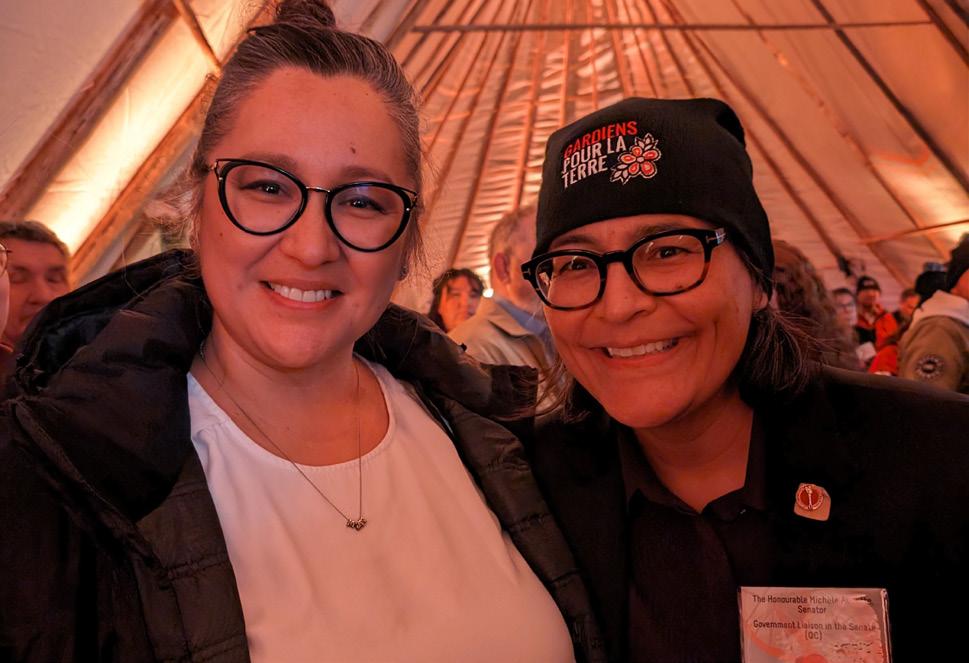

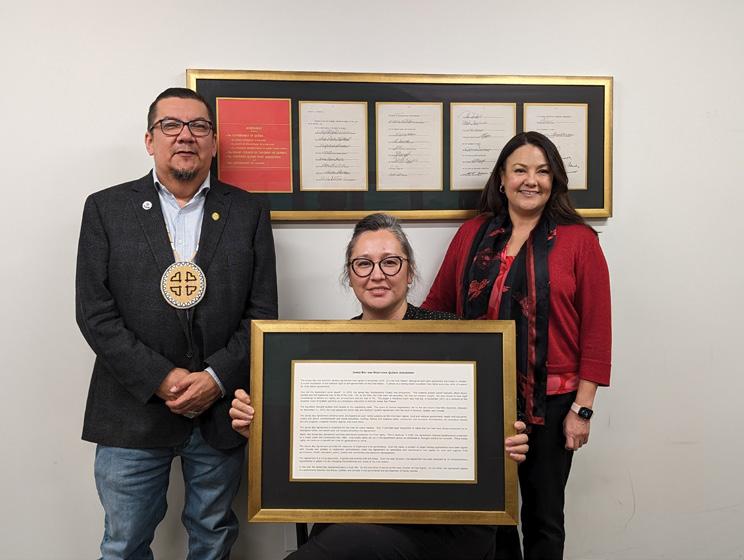

www.nationnews.ca February 23, 2024 the Nation 23
STATE OF THE NATION

Here’s another edition of the Nation’s puzzle page. Try your hand at Sudoku or Str8ts or our Crossword, or better yet, solve all three and send us a photo!* As always, the answers from last issue are here for you to check your work. Happy hunting.
5 Tumbler, e.g.
10 Track figures
14 Lender's protection
15 Renegade
16 Sign of secrecy
17
19 Salinger girl
20 Bringing up the rear
21 Obtained
23 Knotted neckwear
25
29

24 the Nation February 23, 2024 www.nationnews.ca ACROSS
Goya's
1
"Duchess of ___"
All-powerful
26
Except that
Part of HMO
Reach,
World
mo.
Radio and TV, e.g.
Hero's award 37 Resistance unit 59 Tied up 7 Get on in years 35 Banned apple 38 Dye ingredient 60 Mosquito repel- 8 Phoenix team spray 40 Tavern offering ling candle 9 Embark, as on a 36 Danish toy 41 Meat and pota- 62 Parachute pull journey company toes, e.g. 63 They may buckle 10 Rest on top of 39 Lumpy 43 Amber or umber 64 Lunar trench 11 Progeny 42 Relies (upon) 44 Hound 65 Shirley Temple 12 March of ___ 46 Magic show 45 Volleyball film, "Bright ___" 13 Mushers' makeup position 66 Perception vehicles 48 Like arctic 47 Linux software 67 Slip (into) 18 USPS manager winters package, infor- 22 Part of HUAC 49 Chessman mally DOWN 24 Clothes pros 50 Diplomatic 49 Habanero, for 1 Skin cream 26 Horseshoe messenger one ingredient locale 52 "Green ___" 51 Pasta topper 2 Portray artistic- 27 Sound effect 54 Rake part 53 Get what's ally 28 It covers the 56 Hip bones coming? 3 Fudge, as a rule earth 57 Building 55 Keyboard in a 4 Kind of cracker 30 Lobster part additions Bach title 5 Old coin 33 Chop up 58 Breathing rattle 6 Bingo's kin 61 Midmorning hour Crossword by Margie E. Burke Copyright 2024 by The Puzzle Syndicate 1 2 3 4 5 6 7 8 9 10 11 12 13 14 15 16 17 18 19 20 21 22 23 24 25 26 27 28 29 30 31 32 33 34 35 36 37 38 39 40 41 42 43 44 45 46 47 48 49 50 51 52 53 54 55 56 57 58 59 60 61 62 63 64 65 66 67
as a goal 31
Series
32
34
PREVIOUS SOLUTION: Solution to Crossword: 6 8 2 2 16 3 2 1 9 7 © 2024 Syndicated Puzzles 156 351 796 968 342 691 715 854 953 © 2024 Syndicated Puzzles 643251978 125789436 879364152 986473521 431592687 257816349 718945263 562138794 394627815
No. 692 Tough 326897 2317568 84132567 64578 7623154 89436 97862345 5786423 456712 15 3 9 2 8 How to beat Str8ts –Like Sudoku, no single number can repeat in any row or column. But... rows and columns are divided by black squares into compartments. These need to be filled in with numbers that complete a ‘straight’. A straight is a set of numbers with no gaps but can be in any order, eg [4,2,3,5]. Clues in black cells remove that number as an option in that row and column, and are not part of any straight. Glance at the solution to see how ‘straights’ are formed. Previous solution - Medium SUDOKU To complete Sudoku, fill the board by entering numbers 1 to 9 such that each row, column and 3x3 box contains every number uniquely. For many strategies, hints and tips, visit www.sudokuwiki.org If you like Str8ts check out our books, iPhone/iPad Apps and much more on our store. The solutions will be published here in the next issue. You can find more help, tips and hints at www.str8ts.com
692 Easy Previous solution - Very Hard
Puzzles
STR8TS
No.
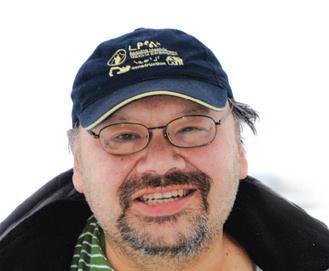

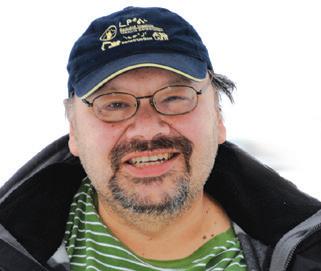
NEl Niño
by Sonny Orr
ow that the world’s attention seems to be more focussed on global warming, let’s see how that theory works in the North. Here warmth is something that happens once or twice during the summer and not in the middle of winter like this year.
Global warming, what do I know? How does my little speck on this planet have any effect or noticeable events that can confirm this theory? Well, I guess for starters, there isn’t a drivable winter road to Whapmagoostui.
These days, winter can’t be relied on to produce thick ice “in time” to make it worthwhile to transport items like building supplies, groceries, vehicles – or most importantly, hockey and broomball players – during the month of February.
Global warming you say?
A modern snowmobile screeches by as it passes over the dry paved road and onto a gravel pathway before reaching some snow or ice. Minutes later, plumes of smoke rise from the new machine, as the owner wails that his snow scratchers aren’t putting enough snow on the cooling mechanisms of his snowmobile.
Why? Because there isn’t enough snow or ice around because of global warming, duh.
Last summer was quite the doozy because of the rampant forest fires, which were set off by some pyromaniac in the middle of Quebec. Now can that be blamed on global warming? Let’s see, the
I hear that this summer will be a repeat of last year, minus the pyromaniacs hopefully
low levels, mainly because the electricity demand from the south put strains on the storage capacity of one of the world’s largest hydro generating facilities.
Why? Because it was so hot and dry making it damn near impossible to spit out dust and smoke debris, from global warming. I hear that this summer will be a repeat of last year, minus the pyromaniacs hopefully.
Arriving in record flocks, the spring geese concentrated their migration times to only a few solid days, just to get the mother goose far enough north to lay some golden eggs. Sadly, many of them decided to stay in the south year-round, giving rise to a new species of waterfowl – the urban goose and backyard duck that are now normal for the south.
Why? Because global warming made migration redundant as temperatures don’t vary as much from the south to the north. Plus, all those fires made living in
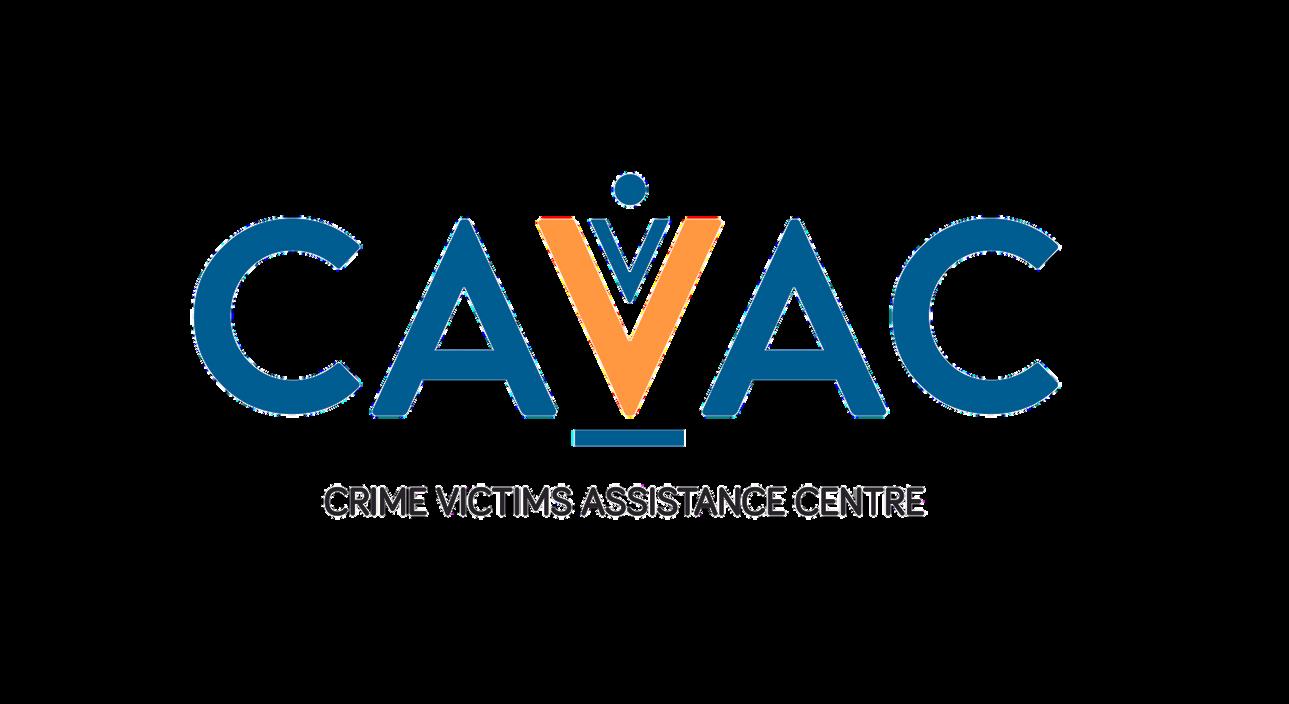
The new tourist, someone from the sweaty tropical zone south of 55, is now looking towards the North to cool down and hopefully settle in an area that isn’t at war or under civil strife, or doesn’t have poor living conditions and standards, or isn’t crazy hot that you go insane from heat stroke.
Why? Because global warming and population distress makes our True North strong and free. It’s the next frontier to grab and settle because your ice cream cone doesn’t melt so quickly that you mistake it for a milkshake. Why? Because of global warming.
If it seems that I am wrong with all these assumptions, it’s because I am now fully programmed to accept another excuse why the world is going to hell in a basket of bannock. If I choose to believe it, I should be able to cook that bannock on our new paved roads, because that’s how hot it’s going to get. I recommend adding a slice of baloney to that to make


25
Rez
Notes
T T T 1-877-342-2822 Are you a victim or witness of a criminal act? We are here to support you Our services are offered throughout Eeyou Istchee and are strictly confidential. C A L L U S A program offered by: ᐃᔨᔨᐤ CAVAC ᐋ ᐱᒥᐱᔨᐦᑖᑭᓂ ᐃᒡ
Valentine’s Day and the power of love
by Xavier Kataquapit
We celebrate Valentine’s Day with wishes for those we are romantically interested in or in general for good greetings to family and friends. However, the history of this day that is celebrated on February 14 is very different.
Everyone grows up with the annual traditions that their parents followed without question. It is stranger to follow long-standing European traditions when you come from an Indigenous background. We simply followed traditions like Valentine’s Day like the rest of Canada as we were told, and no one ever wondered why. Early on it was viewed as a Christian holy day, but over the past few generations it seems to have lost its Christian significance.
My parents were born in the James Bay wilderness, and they followed a traditional lifestyle that was based on the changes of the seasons. The most important times for us were when the waterways froze, when the ice broke up. Other times were marked for when a bird species arrived, or the arrival of fish or the migrations of caribou herds. The days we commemorated had to with our survival. But when Christian missionaries began imposing their religion on us, we started commemorating holy days like Valentine’s Day.
I was surprised to learn that many of the Christian holidays we celebrated originated as pagan days of worship. Valentine’s Day is steeped in pagan history and full of controversy and tragic violence. There is some evidence that this day was designed to replace the pagan celebration of Lupercalia, which had to do with celebrating fertility.
Valentine’s Day became a day of sharing loving greetings in the Middle Ages and the fact that it came out of pagan fertility celebrations makes sense. In the 1700s and 1800s, the celebration of Valentine’s Day took off and people began sharing letters of romantic greetings and then printed cards for those they cared about.
The Christian tradition is that the holiday commemorates the martyrdom of


Saint Valentine in the year 270. However, like many medieval Christian traditions, there are many stories, histories, legends and myths about the identity of Saint Valentine. He is often identified as a leading figure in Rome or someone with the same name in Terni, Italy. Relics of his body, his remains or his items can be found in Rome, Terni, Spain, Ireland and several cities in eastern Europe.
No one is sure who exactly Valentine was, but many identify him as a Christian figure who worked to free other Christians and ended up being imprisoned for his actions. One thing for sure is he became a symbol of opposition to the Roman Empire and pagan beliefs.
Even with all the Christian history, pagan symbology is still prevalent in this holiday. The image of Cupid as a cute naked boy shooting arrows of love is connected to pagan rituals and Greek mythology. He started out as a slender youth named Eros who would shoot arrows of love to cause romance to flourish. Later in history, he became the cute little creature we know today as Cupid.
Valentine’s Day is steeped in mystery, intrigue and violence which gives us reason to pause and consider what it all means. The fact is that no matter the history, the concept of love for others on
a special day is still something wonderful. Today, it has evolved into a money enterprise with the buying of flowers, drinks, chocolates and other gifts associated with this day. I am always happy to get a few chocolates no matter what the reason is so from my point of view that is something wonderful.
Love is something we certainly need more of. We are living in a time of wars that don’t make any sense and are causing widespread death and destruction while making some a lot of money. We are dealing with media propaganda and now artificial intelligence that is impacting us in so many ways. The future of Mother Earth is being threatened by climate change. The military industrial complex is threatening nuclear apocalypse.
We need more love than ever and that means caring more about our planet and all of humanity. We need to realize that it is up to us to stand up to fascism, rightwing ideologies and the very wealthy who continue to make money on war, death and destruction.
Love is a pure and powerful force that we need to tap into. I may not identify with many ancient European traditions, but love is an idea I can understand. Love can change everything.
26 the Nation February 23, 2024 www.nationnews.ca www.underthenorthernsky.com
UTNS

of promo items experience with certified PPPC suppliers 25 of service in Eeyou Istchee 30 514- 272-3077 | info@beesum.com We offer a wide range of services that can assist you in the growth of your business


We offer discounted rates and seat sales. For information, reser vations, or charters call: 1-800-567-6567or visit: www.aircreebec.ca Your Northern Airline of Choice









































 Photos by Johnathan Levert of Nomad Productions
Photos by Johnathan Levert of Nomad Productions

































































